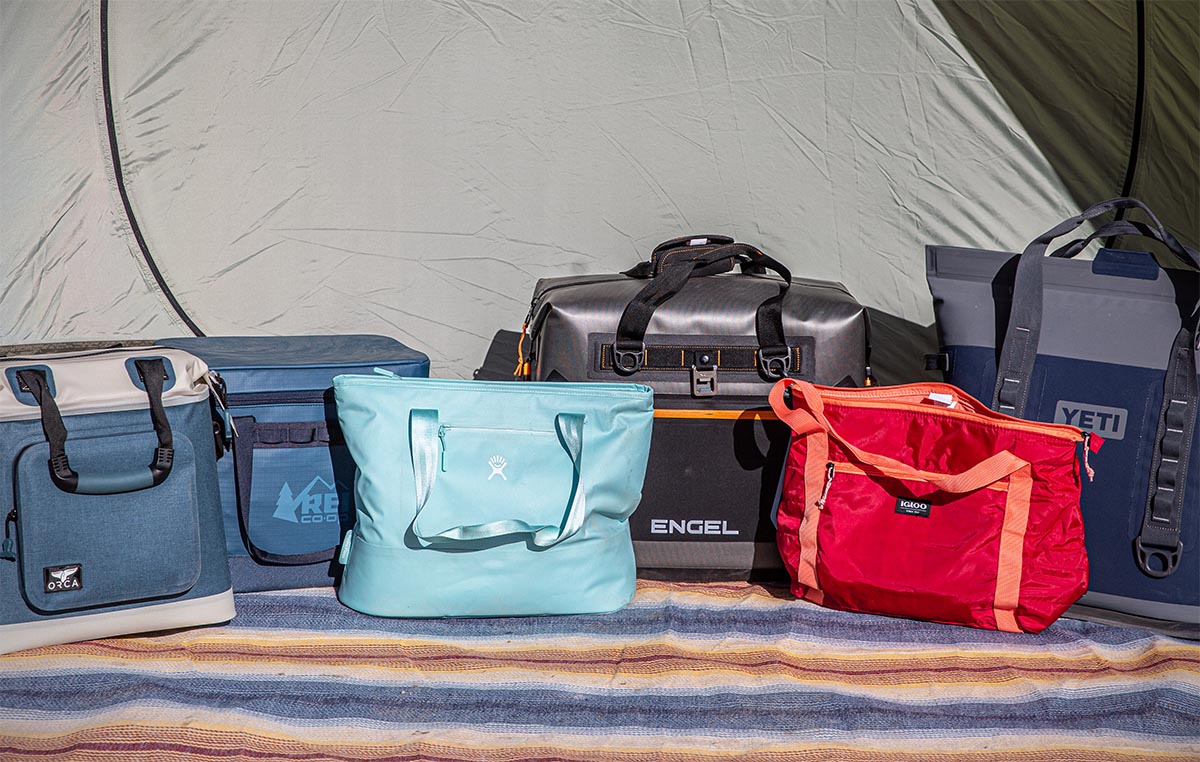
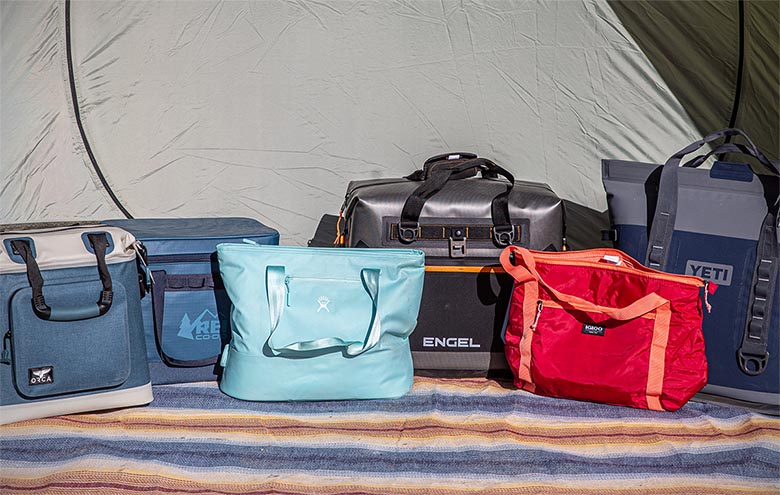
Traditional hard-sided coolers lead the charge in ice retention and durability, but for those who don’t need a week’s worth of cold food and drinks, a soft-sided cooler can be a viable alternative. Compared to hard models, soft coolers are considerably lighter, easier to carry, and often save you a good deal of cash. From burly waterproof options to packable designs that collapse down for easy storage, below we break down the top soft coolers of 2025. For more background information, check out our detailed comparison table and buying advice below the picks, along with details about our testing process. Depending on your intended use(s), we've also compiled lists of the best hard-sided coolers, best backpack coolers, and best wheeled coolers.
Editor's note: We updated this guide on May 16, 2025, to remove several discontinued coolers and add fresh options in their place, including the REI Co-op Campwell and Trailgate, Hydro Flask Tote Bag, and ORCA Wanderer. We also moved some coolers around in our rankings and swept the guide to ensure all other information was accurate at the time of publishing.
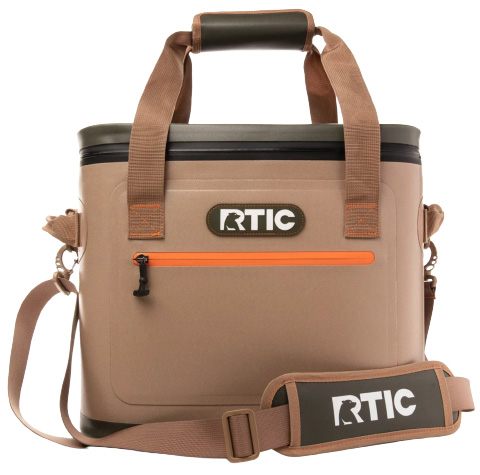 Capacity: 30 cans (with ice)
Capacity: 30 cans (with ice)
Weight: 4 lb. 0 oz.
Other sizes: 12, 20, 40 cans
What we like: A well-built and durable soft cooler at a great price point.
What we don’t: Only sold online; not the most feature-rich design.
The best soft coolers are light enough to easily tote around, can keep contents cold for a day or two, are easy to clean, and stand up well to regular use and abuse. RTIC’s Ultra-Tough Soft Cooler 30 Can fits the bill nicely, combining respectable insulating capabilities and functional features in a robust and premium-feeling package. On the outside, you get a noticeably thick and heavy-duty nylon shell that provides good structure, while 1.5 inches of closed-cell foam on the inside insulate well enough for day adventures or weekend road trips. And a final perk: The Ultra-Tough Cooler floats, making it a great option for activities like rafting and other water sports. At just $129 for the 30 Can model, that’s a whole lot of bang for your buck.
No cooler is perfect, however, and we do have a couple complaints after testing the RTIC Ultra-Tough. First, like many soft coolers, the RTIC takes considerable effort (and two hands) to open, although the zipper is robust, highly leak-resistant, and does a good job sealing in cold. A second gripe is the simplistic organizational layout, which consists of just a single pocket at the front and limits the cooler’s utility for picnics and instances when you’re carrying smaller, non-perishable items. Finally, RTIC is a direct-to-consumer brand and only sells their coolers online, which means you can’t walk into a store to get a feel for the Ultra-Tough before buying. But these are relatively minor downsides, in our opinion, and do little to detract from an otherwise impressively well-rounded and well-built cooler—at a great price point to boot. For another good value from RTIC, check out their packable Everyday Cooler ($50 for the 28 Can version).
See the RTIC Ultra-Tough Soft Cooler 30 Can

 Capacity: 12 cans (with ice)
Capacity: 12 cans (with ice)
Weight: 1 lb. 2.3 oz.
Other size: 6 cans
What we like: A cheap, lightweight, and packable design that will get the job done on day trips.
What we don’t: Basic feature set and still fairly large when collapsed.
If you’re on a budget and simply need a no-frills, portable soft cooler for day trips, the REI Co-op Campwell 18 L Folding Cooler fits the bill. For just $35, the cooler features a nicely sized and easy-to-access interior, portability via the padded shoulder strap or dual top handles, and a flexible design that collapses down for sliding in the back of a vehicle or the crevices of a gear closet. Additionally, the liner is leakproof and easy to clean, and the wide zippered opening makes loading and unloading the cooler a breeze. For grocery runs and casual outdoor use, the Campwell is a cheap but functional option that will get the job done.
It’s worth noting that we previously had AO Coolers’ Canvas Series 24 Pack below listed here, but a recent price jump to $96 makes it less competitive from a value standpoint, especially when pitted against the $35 Campwell. Apart from the sizable savings, the Campwell is better insulated (ice retention is listed at 37 hours compared to 24 for the AO Canvas) and lighter by around 2 pounds. It also folds down much better for storage, although the thick materials result in bit more bulk than expected given the cooler’s low weight and streamlined build. Speaking of streamlined, you only get a single stash pocket that can fit keys and a phone but not much else. Gripes aside, it’s hard to be overly critical of a $35 cooler, earning the Campwell our vote as the best budget design this season. It’s also sold in an 8-liter version for $25, which checks in at 11.9 ounces, can fit 6 cans with ice, and omits a shoulder strap.
See the REI Co-op Campwell 18 L
 Capacity: 42 (without ice)
Capacity: 42 (without ice)
Weight: 6 lb. 12.8 oz.
Other size: 32 cans
What we like: Impressive ice retention for a soft cooler and excellent attention to detail.
What we don’t: Very expensive and overkill for most.
Yeti is the Cadillac of cooler manufacturers and credited with catalyzing the growth of the premium hard-sided market. But their soft-sided offerings are nothing to scoff at and retain much of what’s made the brand so popular over the years, including excellent attention to detail, good ice retention, and decidedly sleek looks. Their top-end M30 is case in point, combining thick, closed-cell foam insulation with a burly and hardwearing shell that’s confidence-inspiring and highly resistant to snags and tears. In testing the Hopper M30, we were also struck by the robust feel of the opening, which uses strong magnets to close shut with quick-release buckles to prevent it from leaking during travel. A final highlight is the accessory-ready exterior, which allows you to easily connect add-ons like their Rambler Bottle Sling or SideKick Dry Gear Case (sold separately).
Unfortunately, however, Yeti’s soft coolers don’t save you much compared to their hard-sided models. In fact, the Hopper M30 retails for $75 more than their similarly sized Tundra 35. It’s true that the Hopper is considerably lighter than the Tundra (by over 14 lb.) and much easier to carry, but it falls well short in ice retention capabilities. Further, while the M30’s magnet-equipped opening is undeniably robust, it’s also very rigid and makes loading and cleaning pretty painstaking (we prefer the wraparound zipper on their smaller Hopper Flip models). Finally, the M30 is large and bulky even when empty and doesn't compress as well as softer and more malleable options like the REI Campwell above or Hydro Flask Tote Bag below. But the Yeti name is hard to beat, and the Hopper M30 has its place for committed day trippers and weekenders looking to maximize portability, durability, and cold retention. For $50 less, Yeti also offers the Hopper M15, which fits 32 cans without ice.
See the Yeti Hopper M30
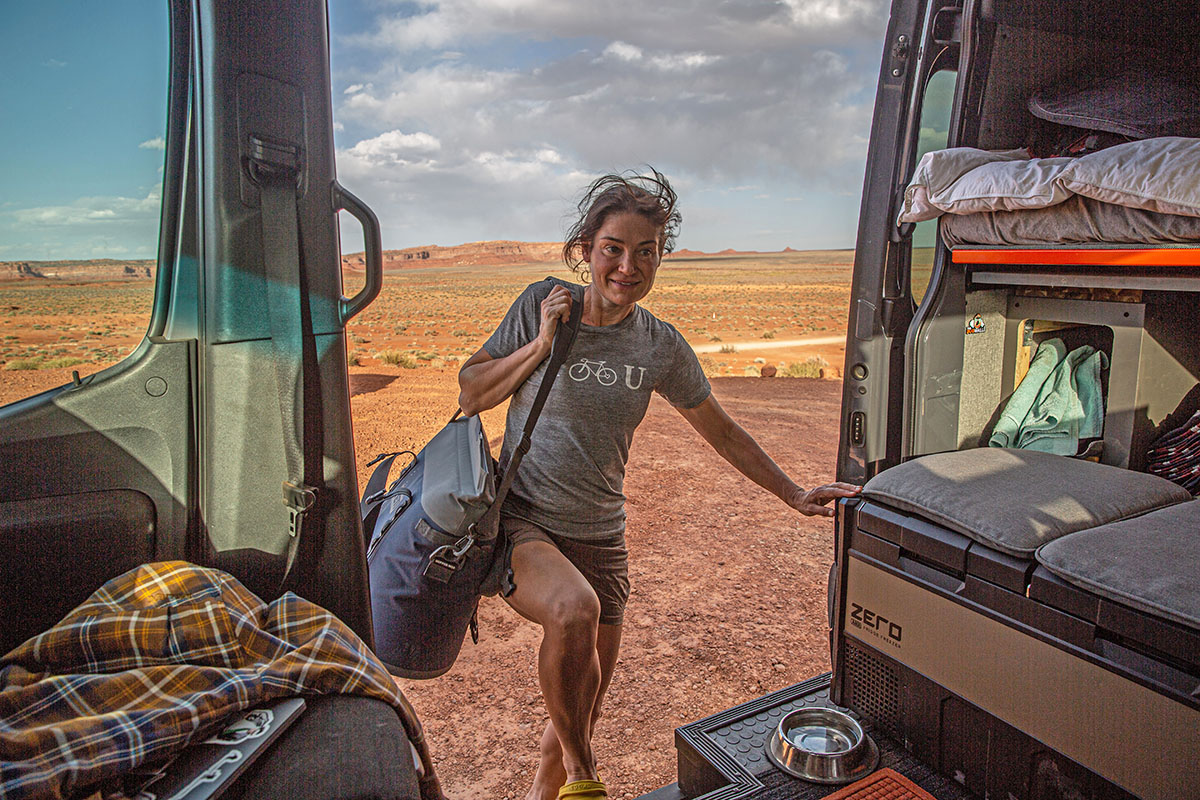
 Capacity: 36 cans (without ice)
Capacity: 36 cans (without ice)
Weight: 2 lb. 10.1 oz.
Other sizes: None
What we like: A sleek and well-built backpack cooler that’s comfortable to carry over longer distances.
What we don’t: Small opening and limited exterior storage.
For the ultimate in portability, backpack-style coolers are the clear winners. And many of these bags, including Hydro Flask’s 20 L Day Escape, share a lot in common with regular daypacks. In terms of carrying comfort, the Day Escape’s shoulder straps are nicely padded and offer good support even when loaded down with ice, food, and beverages, while the handles at the rear and sides ease the on and off process. Other highlights include a waterproof exterior that stands up well to rough use and outer lash points for strapping to a kayak or boat. Finally, we love the smooth-operating zipper that requires minimal force to open (not always the case with watertight designs), provides a reliable seal, and is easy to realign if it separates. All told, the Day Escape’s sleek but well-rounded design was quick to win us over, earning it our endorsement as the best backpack cooler of the year.
What complaints do we have with the Hydro Flask Day Escape? First, the opening is on the smaller side, which makes it difficult to stuff bulkier items like egg cartons through the top (wraparound designs like you get with the RTIC above are much better in this regard). Second, the cooler doesn’t have any zippered storage, although the aforementioned lash points and side water bottle pocket should suffice for most. Finally, there’s no hipbelt for transferring the weight onto your hips, although most people won’t be hauling their cooler more than a mile or so from the car (they’re certainly no substitute for a full-on backpacking pack). But for short jaunts to your favorite picnic spot or fishing hole, the Day Escape is a thoughtfully built and good-looking backpack design with competitive insulating performance.
See the Hydro Flask 20 L Day Escape

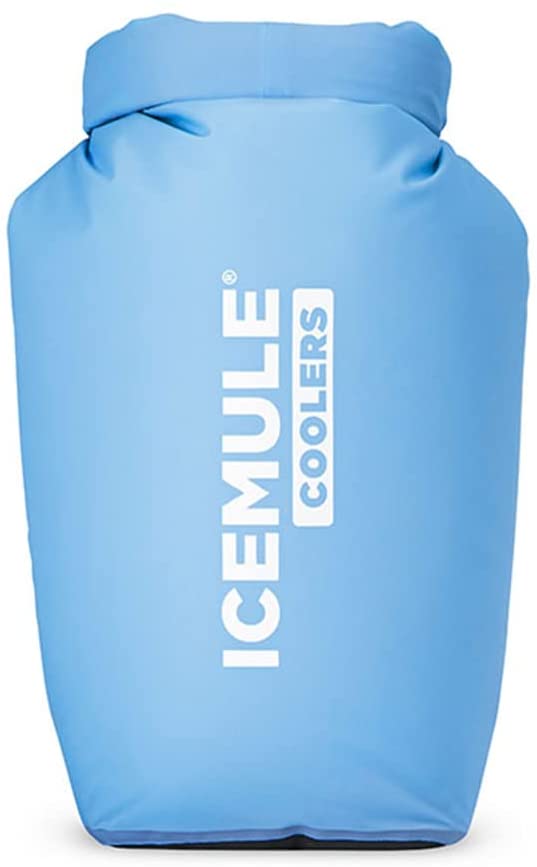 Capacity: 16 cans (with ice)
Capacity: 16 cans (with ice)
Weight: 2 lb. 0 oz.
Other sizes: 10 (9L), 12 (10L), 20 cans (20L)
What we like: Very durable and fully waterproof—a great option for days on the water.
What we don’t: Collapsible design lacks structure.
For those who prefer to spend summer days on the water, a waterproof soft cooler makes a lot of sense. Our favorite design in this category is Icemule’s Classic, which comes in a healthy range of sizes (we like the mid-range Medium 15L best) and checks all the boxes for water sports enthusiasts like paddle boarders and kayakers. All told, it’s nicely sized for quick afternoon outings or full-day adventures, includes a strong and well-cushioned strap for crossbody carry to and from the car, and has a robust, dry bag-like build that should withstand just about all the scratches, scrapes, and tussles that crop up outdoors. The roll-top closure is another selling point, making it easy to create a tight seal and compress the cooler down when it’s only partially full. Finally, we love the integrated air valve that allows you to add extra air to the insulation layer to increase buoyancy (Icemule states it will float even when full) or release air to roll the cooler up for travel and storage.
In order to shave weight and materials, some soft coolers like the Icemule Classic lack structure. Compared to many other soft-sided models here, the Classic can feel a bit sloppy if loaded improperly (the upside is it can be compressed with the roll-top closure). This also translates to less insulating power, although the Classic’s 24 hours of ice retention is actually fairly good in this category. Finally, the 15L model is on the smaller end size-wise, although the 16-can capacity is serviceable for most day trips (and Icemule does offer a larger 20-can variation for $100). These gripes aside, the Icemule Classic offers impressive performance for the price, especially if you plan to take advantage of the reliably leakproof build and water-specific features.
See the Icemule Classic Medium 15L
 Capacity: 20L (~10 cans with ice)
Capacity: 20L (~10 cans with ice)
Weight: 1 lb. 5.1 oz.
Other size: 8L
What we like: A well-built and nicely appointed option for day trips and grocery runs.
What we don’t: Limited utility outside of day-to-day activities.
Soft coolers are a bit of a niche category: They aren’t built to keep ice cold for more than a couple days, but they can be a nice supplement to a larger hard-sided model or a standalone option for those who just need to keep a lunch and beverages cold for the day. For the latter, we love minimalist designs like Hydro Flask’s 20 L Tote Bag. At just $65 and a scant 1 pound 5.1 ounces, the 20 L Tote Bag is a highly affordable and lightweight pick for activities like road trips, grocery and farmers market runs, or short outings to the park or beach. It also compresses down really well for storage, is easy to clean (just wipe down the liner), and boasts a waterproof and durable exterior that stands up well to regular use.
All that said, it’s important to set reasonable expectations with designs like the Hydro Flask. Dubbed an “insulated tote,” the bag is limited in terms of capacity (it can fit around 10 12-oz. cans with ice) and is only rated to keep contents cold for up to 4 hours (the lowest on our list, and we found that estimate to be fairly accurate during testing). In other words, the Hydro Flask is stretching the definition of a “cooler.” But again, many will find it more approachable and useful for day-to-day activities than large, heavy, and pricey alternatives like the Yeti Hopper M30 above or Engel HD30 below.
See the Hydro Flask 20 L Tote Bag
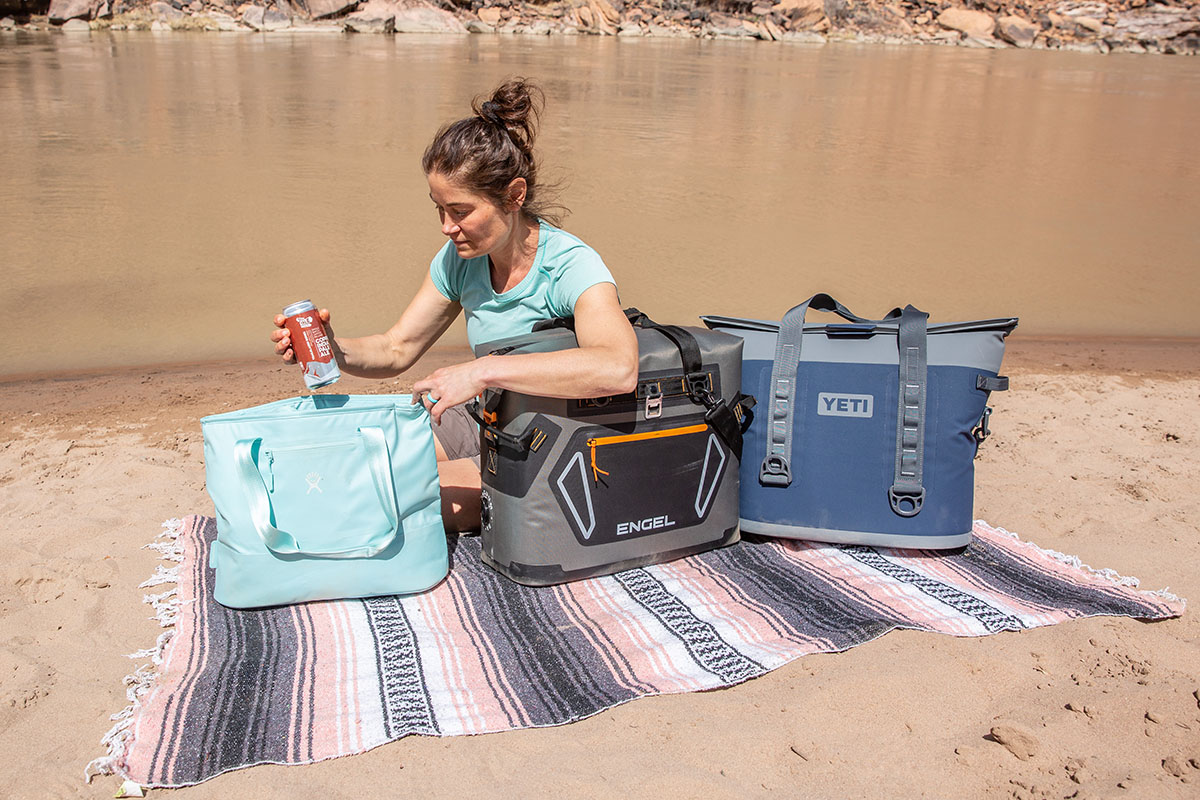
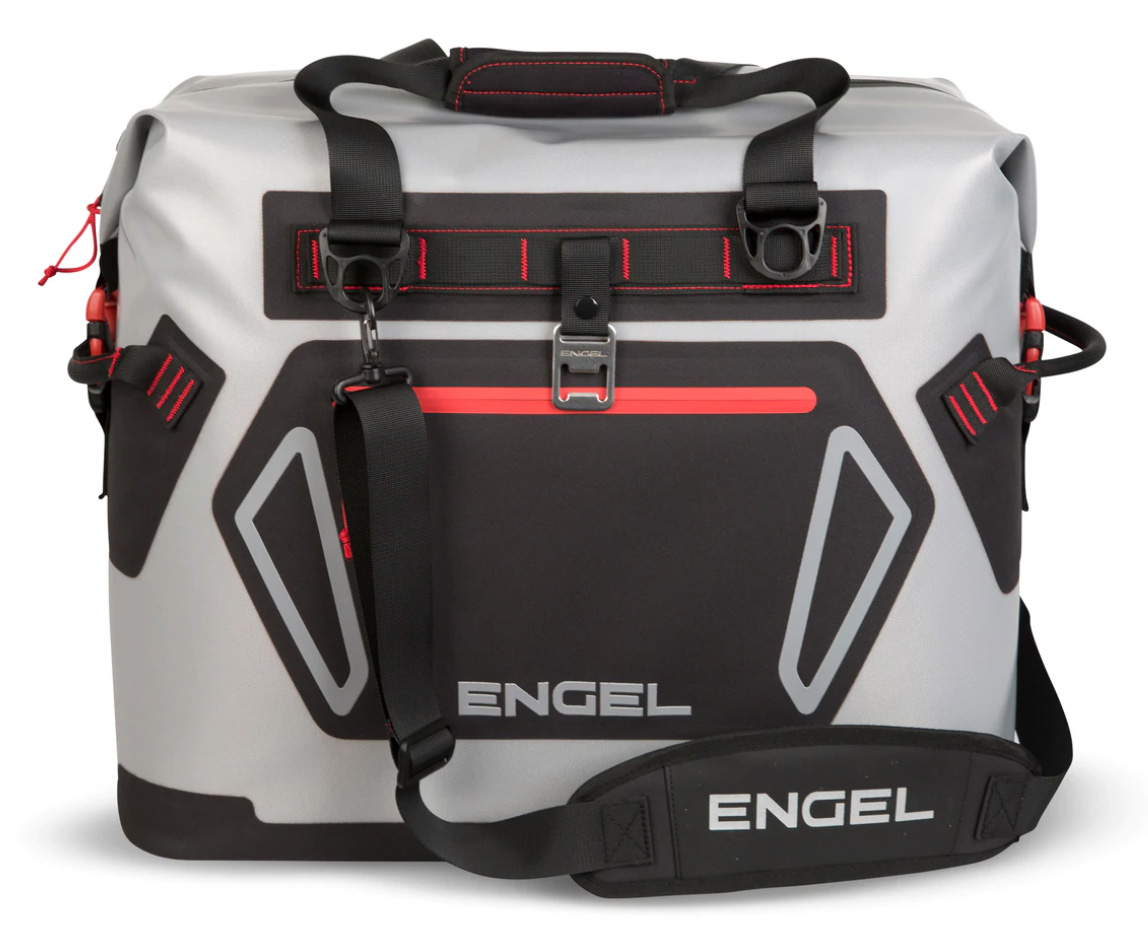 Capacity: 48 cans (with ice)
Capacity: 48 cans (with ice)
Weight: 5 lb. 4.0 oz.
Other size: 24 cans
What we like: Massive capacity and one of the toughest designs on the market.
What we don’t: Expensive and overbuilt for most uses.
Yeti’s Hopper M30 above is the standard bearer in the premium soft cooler market, but Florida-based Engel offers a competitive and cheaper alternative in their HD30. For a significant $150 less than the M30, the HD30 offers a sizable boost in capacity—it can fit 48 cans with ice compared to 42 without ice for the Yeti, making it the largest option on our list by a sizable margin. The Engel also sports a welded construction (most competitors are sewn) that’s designed to seal in cold and minimize leaks, is noticeably robust with an 840-denier shell and TPU film to reinforce the front and back, and can be toted via the thick handles or nicely padded shoulder strap. And a small but thoughtful touch: Engel included an integrated bottle opener, which is fairly uncommon in the soft cooler market and has come in handy on more than one occasion.
It's clear that Engel put a lot of focus on ice retention with their HD collection, including the welded construction, sealed zipper, and vacuum valve at the side that allows you to suck out excess air before use. In testing, we found that the cooler sealed nicely, which was a pleasant surprise given the zippered opening, but it didn’t keep our ice frozen for nearly as long as expected. For reference, Engel lists the cooler’s ice retention at three to four days, but ours only kept ice frozen for around 48 hours during testing in Utah. Further, the design takes considerable force to open: The zipper is noticeably stiff and requires lubrication to run smoothly (Engel does include a small tube with purchase), and the buckle-equipped “wings” at the sides only make the process more effortful. But again, this does help with leak-proofing, making the Engel an especially capable pick for water-based activities like kayaking, paddle boarding, rafting, and more.
See the Engel HD30
 Capacity: 24 cans (without ice)
Capacity: 24 cans (without ice)
Weight: 3 lb. 0 oz.
Other sizes: 11, 30 cans
What we like: A lighter and more approachable alternative to the M30 above.
What we don’t: Limited capacity and still very pricey.
Yeti’s Hopper M30 above is the crème de la crème of soft coolers, but it’s overbuilt and overpriced for many. Enter their Hopper Flip 12, which retains much of what we love about the M30 in a lighter, cheaper, and more approachable package. Like its pricier sibling, the Hopper Flip 12 utilizes their DryHide shell that’s incredibly tough and tear-resistant, insulates well with thick closed-cell foam, and comes with Yeti’s HitchPoint grid to easily attach accessories like a bottle opener or dry gear case. Unlike the M30, however, the Hopper Flip 12 is very easy to load and unload with a well-executed, zipper-equipped opening that’s wide, fully leakproof, and provides nearly uncompromised access to food and beverages. We also appreciate the comfortable shoulder strap and plethora of handles on the sides of the cooler for easy maneuvering.
At $250, however, the Yeti Hopper Flip 12 certainly doesn’t stand out from a value perspective. It’s true that it will save you $100 compared to the top-end Hopper M30 above, but capacity is decidedly limited (the Hopper Flip can fit 24 cans without ice compared to 42 for the M30). And for a significant $120 savings, RTIC's Soft Pack 30 above offers a sizable boost in storage space without compromising much in quality, while Engel’s HD30 can swallow a whopping 48 cans (with ice) for $50 less. To be fair, the Hopper Flip 12 is perfectly serviceable for an afternoon at the beach or quick after-work paddle, but the high price tag and small capacity are enough for us to push it down to a mid-pack finish.
See the Yeti Hopper Flip 12
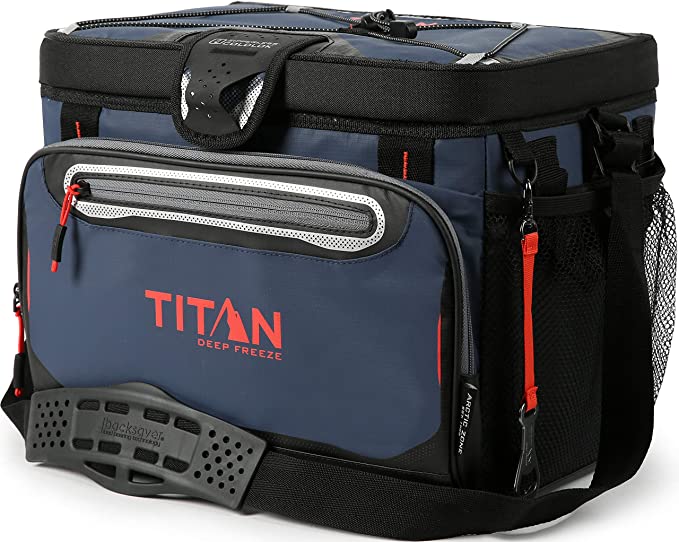 Capacity: 30 cans (without ice)
Capacity: 30 cans (without ice)
Weight: 3 lb. 10.2 oz.
Other sizes: 9, 12, 16, 24, 48 cans
What we like: Cheaper and more features than the AO Coolers 24 Pack below.
What we don’t: Not a standout in build quality or cold retention.
Like the REI Campwell above, Arctic Zone’s Titan 30 Can Zipperless Hardbody Cooler stands out in one key area: value. For a very affordable $63, the Titan combines a generous 30-can capacity with functional—and decidedly unique—features for everything from quick trips to the beach or local state park to weekend adventures farther from home. One standout addition is the zipperless lid, which quickly flips open for nearly effortless access to food and drinks and secures closed via a Velcro flap. We also love the included plastic “shelf,” which effectively separates hard items like cans from softer foods like sandwiches and produce. And the exterior is very well appointed with generous zippered storage, a separate side mesh pocket, an included bottle opener, and a stretchy bungee system at the top for securing things like an extra layer or towel.
However, while we love the easy access to the interior, the Titan’s zipperless design does have a notable pitfall: It doesn’t seal in cold as well as much of the competition. For reference, Arctic Zone lists the cooler’s ice retention at three days, but many users put it closer to a day at maximum in summertime heat. Build quality is another concession at this price point: The Titan has a cheaper feel overall, and the thin plastic liner in particular strikes us as a point of weakness that may be prone to cracking over time. But you’d be hard-pressed to find a better combination of features and price, and the Titan is also sold in backpack and wheeled options for those who want to explore a different style.
See the Arctic Zone Titan 30 Can
 Capacity: 38 cans (without ice)
Capacity: 38 cans (without ice)
Weight: 2 lb. 12.0 oz.
Other sizes: 20 cans (12L)
What we like: A nice middle ground in terms of price and overall performance.
What we don’t: Basic feature set.
The third Hydro Flask design to make our list this season is the 20 L Carry Out Soft Cooler, which splits the difference between their 20 L Tote Bag and backpack-style Day Escape above. For just $90, the Carry Out is the largest option of the bunch with a 38-can capacity (without ice), and the wraparound zipper makes access and cleaning quick and easy. Insulating performance is also respectable for the price—the Carry Out is rated to keep ice frozen for up to 24 hours, which is a significant 20 hours longer than the Tote Bag and only 12 hours less than the $110-pricier Day Escape. And like the premium Day Escape, the Carry Out boasts a thick (600D) exterior that’s highly durable and water-resistant, along with welded seams to keep spills and splashes at bay. Tack on a handy stash pocket at the front and webbing loops to attach Hydro Flask’s Dry Storage accessories, and the Carry Out stands out as an excellent value for what you get.
All told, the Hydro Flask Carry Out hits a great middle ground in the soft-sided cooler market: While slightly pricier than true budget designs from brands like REI Co-op, Coleman, and Arctic Zone, it’s a notable step up in all-around quality and cooling capabilities. On the flip side, you can get far better insulating performance from more premium options like the Yeti Hopper M30 or Engel HD30 above, both of which also offer more storage and features. But it’s hard to be overly critical at this price point, and there's no denying that the Carry Out offers great bang for your buck. For a similarly built but smaller option for personal use and quick day trips, check out Mountainsmith’s $55 Cooler Cube.
See the Hydro Flask 20 L Carry Out
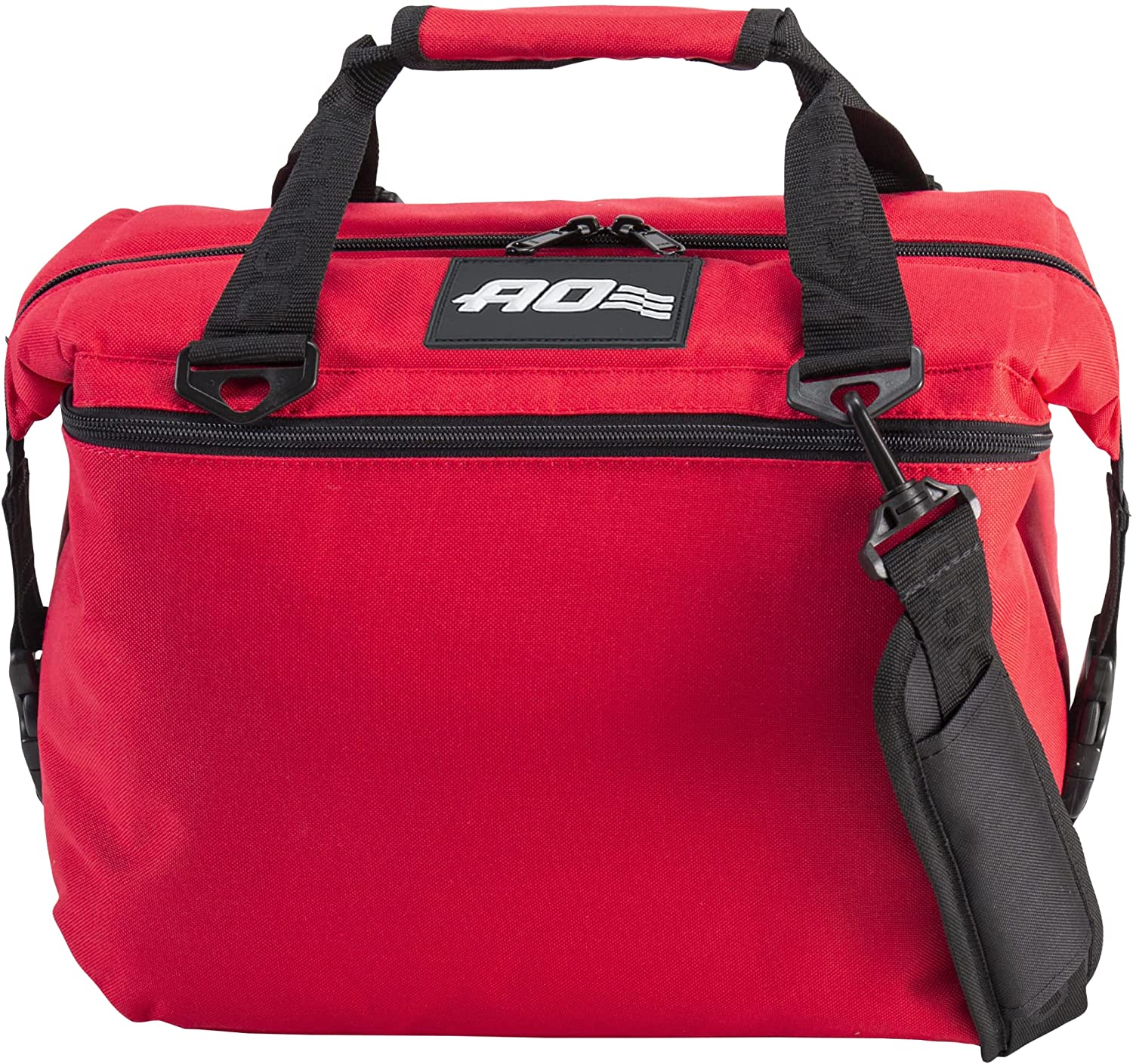 Capacity: 24 cans (with ice)
Capacity: 24 cans (with ice)
Weight: 3 lb. 0 oz.
Other sizes: 12, 36, 48 cans
What we like: Compact, simple design performs well for day trips.
What we don’t: Canvas build is less durable and water-resistant than many of the picks here.
For a step up in performance from true budget designs like the REI Campwell above, we think AO Coolers’ Canvas Series 24 Pack is worth considering. For just under $100 full MSRP (some colorways are a little cheaper on Amazon at the time of publishing), you get a compact and easy-to-shoulder design, a functional zippered closure that runs the length of the cooler, and a generous exterior pocket to stow an extra layer or valuables. We also appreciate that the interior liner can be pulled out, washed, and left out to air dry before storage to prevent mustiness over time. Don't expect multi-day ice retention (AO advertises a 24-hour maximum) or huge capacity (it fits up to 24 cans), but for short adventures to the beach or park, the AO may be all you need and nothing you don’t.
What do you sacrifice with the AO Coolers 24 Pack? For starters, the canvas build—while capable for many casual uses—falls well short of the higher-end options on this list in durability, water resistance, and cold retention. Carrying comfort is another concession: The shoulder strap is very basic and lacks padding and support for covering longer distances. Finally, the 24 Pack is fairly basic and lacks features like daisy chain webbing or external attachment points for accessories. But many will find these downsides reasonable given the AO’s sub-$100 price tag, earning it a spot on our list this season.
See the AO Coolers Canvas Series 24 Pack
 Capacity: 18 cans (with ice)
Capacity: 18 cans (with ice)
Weight: 4 lb. 8.0 oz.
Other size: 24 cans
What we like: Respectable performance and features for the price.
What we don’t: Doesn’t stand out in any major way.
REI has a knack for balancing performance and affordability, and their Trailgate 20 L Weekend Cooler is no exception. Replacing the brand’s Cool Haul line for 2025, the Trailgate retains a lot of what we loved about the outgoing design, including easy portability via the top and side handles or adjustable shoulder strap, a durable but soft nylon shell that keeps weight relatively low, and a low-profile but accommodating shape that takes up minimal space in a trunk or backseat. It’s also pretty affordably priced at $130 (the Cool Haul 24 was $139) and includes a healthy assortment of features, including a rigid lid that works great as a prep surface, an integrated bottle opener, and a generously sized zippered pocket at the front. And because the Trailgate’s inner insulated box can be separated from the outer shell, cleaning is a snap (the shell can also be used without the liner as a tote).
Where does the Trailgate 20 fall short? In a competitive market, it’s simply hard to stand out. For instance, the AO Coolers Canvas Series 24 Pack above boasts a slightly larger capacity (24 cans with ice) for around $35 less, although you do get better cooling capabilities with the REI. And on the premium end of the spectrum, brands like Yeti, RTIC, and Hydro Flask have better-insulating and more durable offerings for a major bump in price. But in the end, it’s hard to fault the REI as a solid, affordable pick for small group outings. Note: It’s also available in a larger 30-liter version that can fit 24 cans with ice, which is a similarly strong value at $160.
See the REI Co-op Trailgate 20 L
 Capacity: 28 cans (without ice)
Capacity: 28 cans (without ice)
Weight: 6 lb. 12.0 oz.
Other size: 14 cans
What we like: Zipperless design allows for quick and easy access; tall enough for wine bottles.
What we don’t: Cheap-feeling closure system and strap attachments; a bit awkward to carry.
ORCA—short for Outdoor Recreation Company of America—may not be a household name like Yeti or Hydro Flask, but we’ve had positive experiences with the brand’s coolers over the years. Their soft-sided offering is the Wanderer, and we like the top-of-the-line 28-can model best. Like the Arctic Zone Titan above, the Wanderer is a zipperless design that allows for quick and easy access—simply undo the two latches and grab what you need. The body of the cooler is tough and rigid, providing excellent protection, and the tall shape can accommodate wine bottles upright (which can’t be said of most options here). Rounding out the build, ORCA included a waterproof lining that’s easy to clean, three stretchy mesh pouches for stashing small essentials and cooking accessories, and an adjustable shoulder strap that can be removed if you prefer to carry the cooler by the dual side handles.
What pushes the ORCA Wanderer 24 toward the bottom of our list? First, despite being on the pricier end at $250, we were underwhelmed by the quality of the latches and shoulder strap attachment points, all of which are made of flimsy plastic. We haven’t had any issues yet, but all of these pieces strike us as susceptible to breaking over time. The 28-can model is also pretty heavy and bulky, which makes it slightly awkward to carry over one shoulder (the smaller 14-can version is more manageable but can’t fit wine bottles). To be sure, we love the combination of generous capacity and hardwearing exterior, but the fact that you can pick up Yeti’s Hopper Flip 12 above for the same price (which is less than half the weight and much better insulated) doesn’t bode well for the ORCA's ranking on our list. Of note: In addition to the 14- and 28-can models, ORCA also offers the 25-can Wanderer Tote, although it has a different shape and strap design.
See the ORCA Wanderer 24
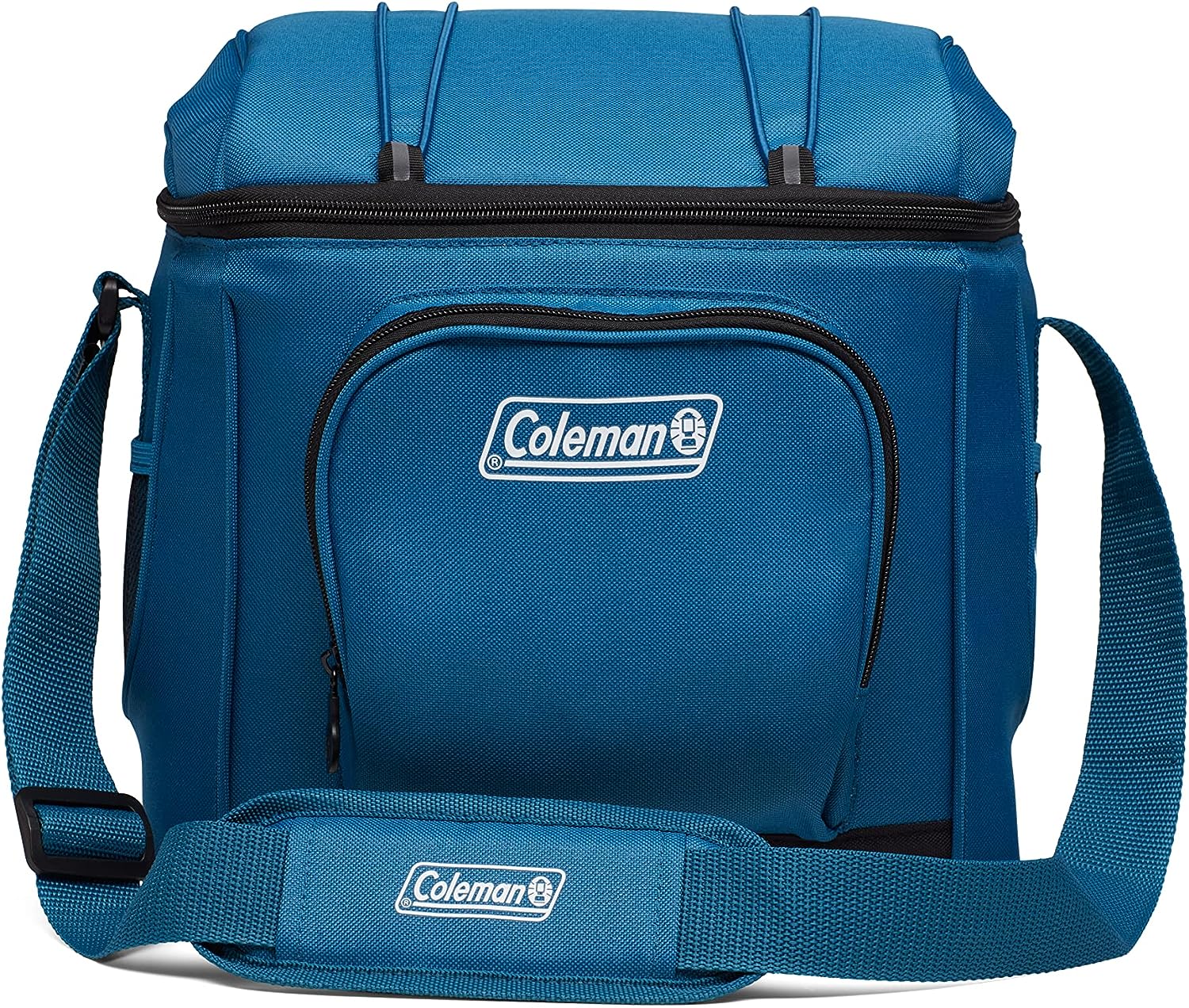 Capacity: 16 cans
Capacity: 16 cans
Weight: 2 lb. 1.6 oz.
Other sizes: 9, 30 cans
What we like: Affordable, lightweight, and easy to clean.
What we don’t: The least performance-ready cooler on our list.
Soft coolers can get pretty expensive, as evidenced by Yeti’s $350 Hopper M30 above. But if you only plan to use your cooler a couple weekends each summer, a true budget design like Coleman’s Chiller 16-Can could very well get the job done at a fraction of the cost. Right off the bat, we’ll note that the Coleman is the least performance-ready option on our list. In other words, don’t expect any miracles in terms of ice retention or longevity. But if you set reasonable expectations, you probably won’t be disappointed: The Coleman will keep your food and beverages adequately cold for the day and easily outlast its bargain-basement price tag.
Why the last-place finish for the Coleman Chiller 16-Can? While many users note that cold retention was better than expected for the price, it still falls short of other budget options like the REI Campwell and Arctic Zone Titan above in overall performance and build quality. To be fair, the Coleman does get the edge in features over the Campwell with more exterior pockets and lash points, but insulation is often the more important consideration. For a nice middle ground between the aforementioned budget designs and premium offerings, Coleman’s own Pro Soft Cooler ($60 for the 16-Can capacity) is a much tougher and more reliable alternative.
See the Coleman Chiller 16-Can
| Cooler | Price | Capacity | Weight | Other Sizes | Ice* |
|---|---|---|---|---|---|
| RTIC Ultra-Tough 30 Can | $129 | 30 cans (with ice) | 4 lb. 0 oz. | 12, 20, 40 cans | 48 hours |
| REI Co-op Campwell 18 L | $35 | 12 cans (with ice) | 1 lb. 2.3 oz. | 6 cans | 37 hours |
| Yeti Hopper M30 | $350 | 42 cans (without ice) | 6 lb. 12.8 oz. | 32 cans | Unavail. |
| Hydro Flask Day Escape | $200 | 36 cans (without ice) | 2 lb. 10.1 oz. | None | 36 hours |
| Icemule Classic Medium | $85 | 16 cans (with ice) | 2 lb. 0 oz. | 10, 12, 20 cans | 24 hours |
| Hydro Flask 20 L Tote Bag | $65 | ~10 cans (with ice) | 1 lb. 5.1 oz. | 8L | 4 hours |
| Engel HD30 | $200 | 48 cans (with ice) | 5 lb. 4.0 oz. | 24 cans | 72-96 hours |
| Yeti Hopper Flip 12 | $250 | 24 cans (without ice) | 3 lb. 0 oz. | 11, 30 cans | Unavail. |
| Arctic Zone Titan 30 Can | $63 | 30 cans (without ice) | 3 lb. 10.2 oz. | 9, 12, 16, 24, 48 cans | 3 days |
| Hydro Flask 20 L Carry Out | $90 | 38 cans (without ice) | 2 lb. 12.0 oz. | 20 cans | 24 hours |
| AO Coolers Canvas 24 Pack | $96 | 24 cans (with ice) | 3 lb. 0 oz. | 12, 36, 48 cans | 24 hours |
| REI Co-op Trailgate 20 L | $130 | 18 cans (with ice) | 4 lb. 8.0 oz. | 24 cans | 72 hours |
| ORCA Wanderer 24 | $250 | 28 cans (without ice) | 6 lb. 12.0 oz. | 14 cans | Unavail. |
| Coleman Chiller 16-Can | $38 | 16 cans | 2 lb. 1.6 oz. | 9, 30 cans | 12 hours |
*Editor's note: This number represents claimed ice retention. In real-world use and depending on the specific circumstances, we've found these times to be quite a bit lower. More in our "Ice Retention and Cooling Capabilities" section below.
As much as the Switchback Travel team loves grueling, “type 2” fun in the backcountry, we also know how to enjoy creature comforts like fresh food and cold beverages at camp on mid-summer days. Managing editor Sarah Nelson kicked off this list in 2022 with 16 soft-sided coolers. Formerly on the road full-time in a self-converted van, Sarah loves to geek out on camping gear and is intimately familiar with the cooler market—from hard-sided designs for maximum ice retention to soft coolers for day trips. Editor Maddie Downie took over the guide in 2024. Based in Bellingham, Washington, Maddie continues to revise the list based on her experiences car camping and exploring the Pacific coast.
Our current lineup of 14 coolers reflects our ongoing testing experiences, firsthand info from contributors, and feedback from the online camping community. When we put soft coolers to the test, we start by exposing them to the elements—from stuffy, hot cars to tree-shaded campgrounds—and evaluating how long they keep ice frozen. We also test for portability and carrying comfort by filling them to the brim and hauling them into camp. Finally, we look closely at each cooler’s features, making note of how smoothly the zippers operate, the level of padding on the shoulder straps, and how well everything is integrated into the design. We recognize that the soft cooler market isn't static and, as a result, continue to test new and noteworthy designs as they become available.
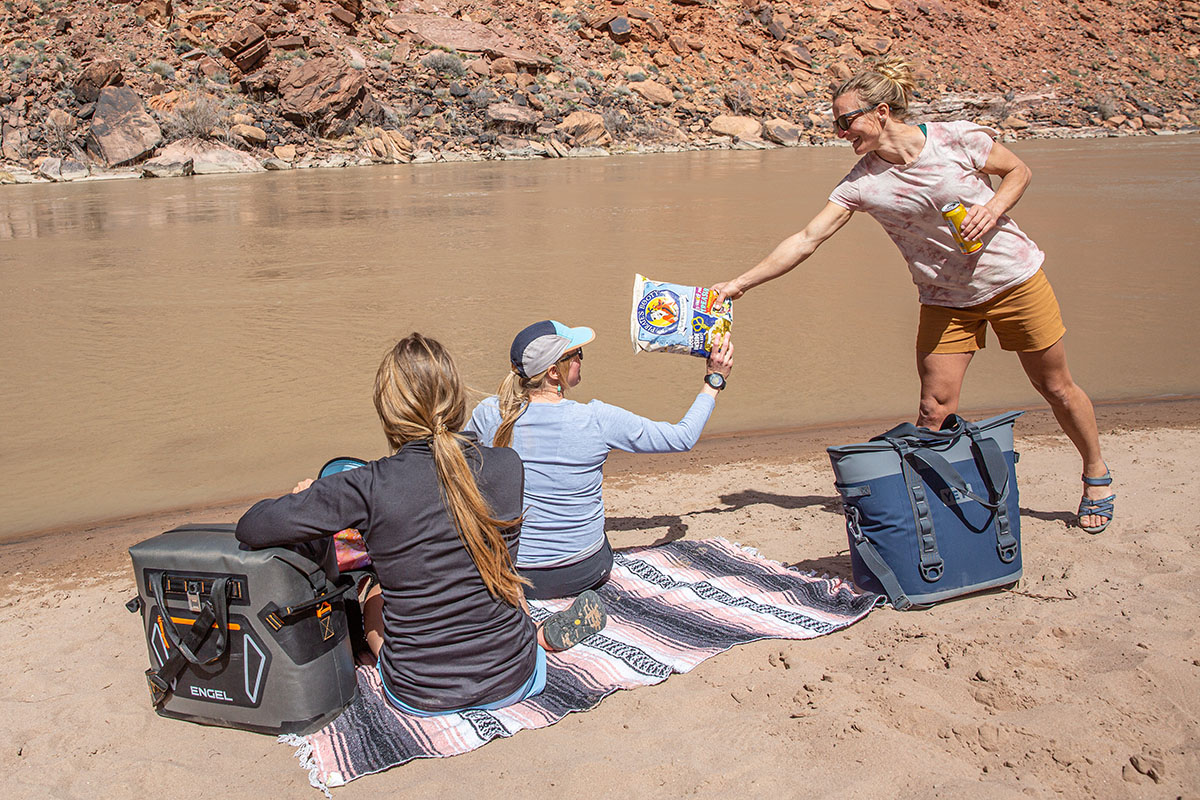
Before diving into the finer details, it’s important to point out that soft coolers come with some inherent compromises. Unlike hard-sided models that can keep food and beverages cold for days (or even weeks) on end, soft models aren’t built to keep contents cold for more than a few days at maximum. They’re also generally much smaller than hard-sided designs, typically offering around 30 liters of capacity at the high end. With this in mind, soft coolers have limited appeal for multi-day outings. Instead, they’re best-suited for weekend getaways or day trips to the park or beach, tailgates, afternoons on the water, or quick errands like grocery store runs. They can also be a great supplement to a larger hard-sided model, providing additional space to store extra food or beverages when camping with a larger group.
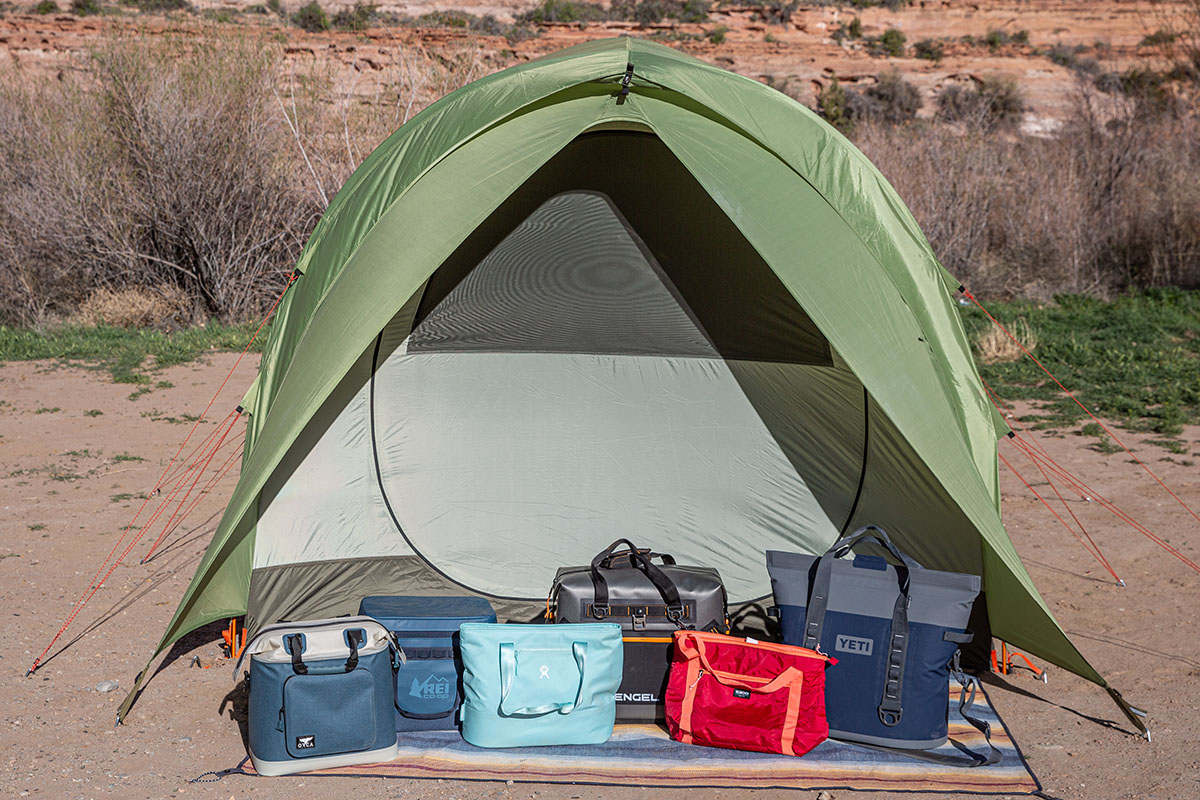
Additionally, there’s an important distinction to be made between collapsible designs and rigid soft coolers: In our experience, flexible and packable models like the Hydro Flask 20 L Tote Bag are far more versatile and functional than thick and rigid options like the Engel HD30. Not only do they lack drainage ports to dump excess water once ice has melted, these more rigid designs also don’t compress down for storage when not in use (a major reason why one might choose a soft cooler in the first place) and won’t retain ice for nearly as long as hard-sided models. They also generally cost the most among soft-sided offerings, which begs the question: Why not just buy a similarly priced hard cooler? To be sure, rigid designs like the Engel are still much lighter and more portable than hard coolers, but it’s important to consider the drop in durability, insulating capabilities, and overall capacity when weighing your options.
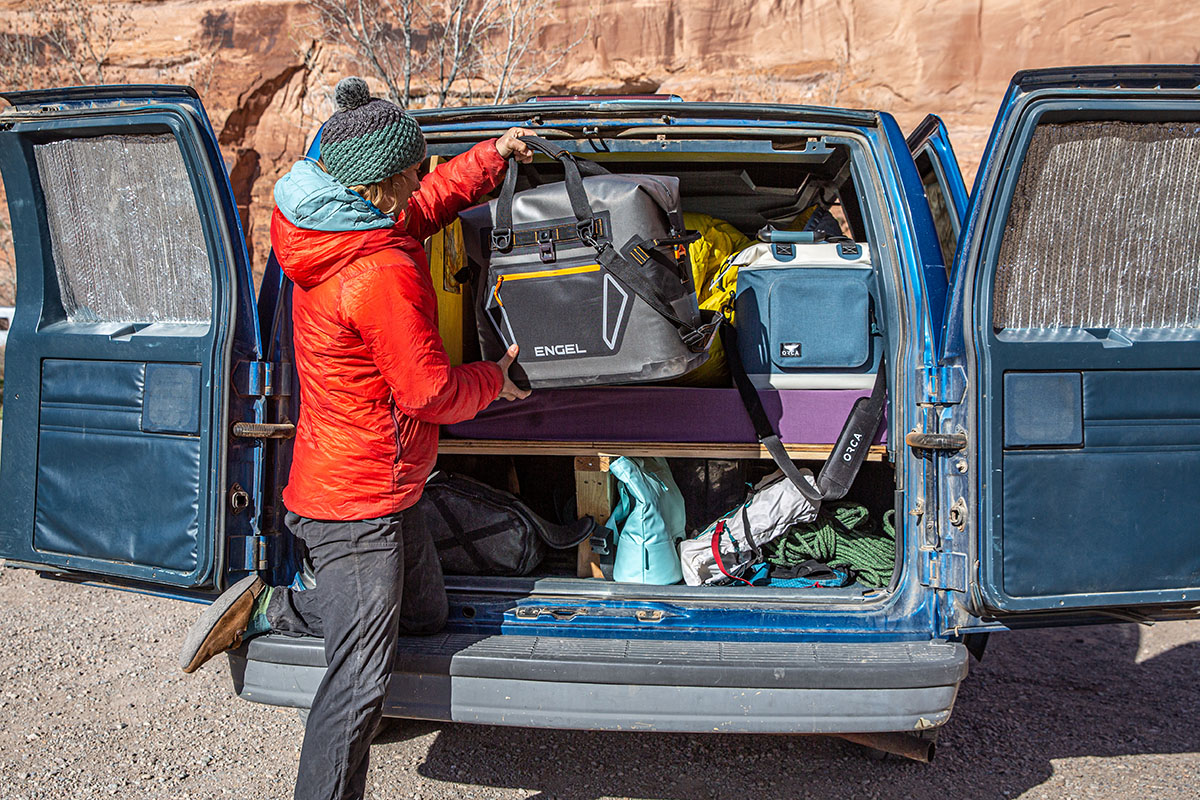
Importantly, not all coolers measure interior capacity in the same way. Some use cans as a unit of measure, while others use liters, quarts, or gallons. That said, “cans” is the most commonly used measurement for soft coolers (hard-sided models are generally listed in quarts), and we’ve utilized that spec throughout this article whenever available. That said, there are still some discrepancies to be aware of, the biggest of which is whether or not ice is included in that estimate. We did our best to clarify in the write-ups and comparison table above, but it’s an important distinction to keep in mind when shopping for a soft cooler.
For reference, the largest option above is the Engel HD30, which can fit up to 48 12-ounce cans with ice, while the smallest is Hydro Flask’s 20 L Tote Bag, which we found fits around 10 cans with ice (Hydro Flask does not provide an exact spec). In our experience, the sweet spot is often right in the middle, with many of our most frequently used soft coolers offering space for around 18-24 cans with ice. These designs are sufficiently sized for day trips or weekend road trips, manageable in terms of weight and portability, and won’t take up a ton of space in your vehicle or garage.

As we covered above, soft coolers are relatively poor performers in terms of ice retention—most can only keep contents cold for a day or two at maximum in ideal (read: favorable) conditions. External factors play a huge role here, including air temperature, how frequently you open the lid, the amount of sunlight you expose the cooler to, and how much ice you use (most brands recommend a 2:1 ice-to-food ratio). For maximum performance, you can pre-chill your cooler prior to loading it up by filling the interior with ice for at least a few hours to bring its interior temperature down. When you’re ready to hit the road, swap in some pre-chilled packs or fresh ice at that optimal ratio along with your drinks and food.
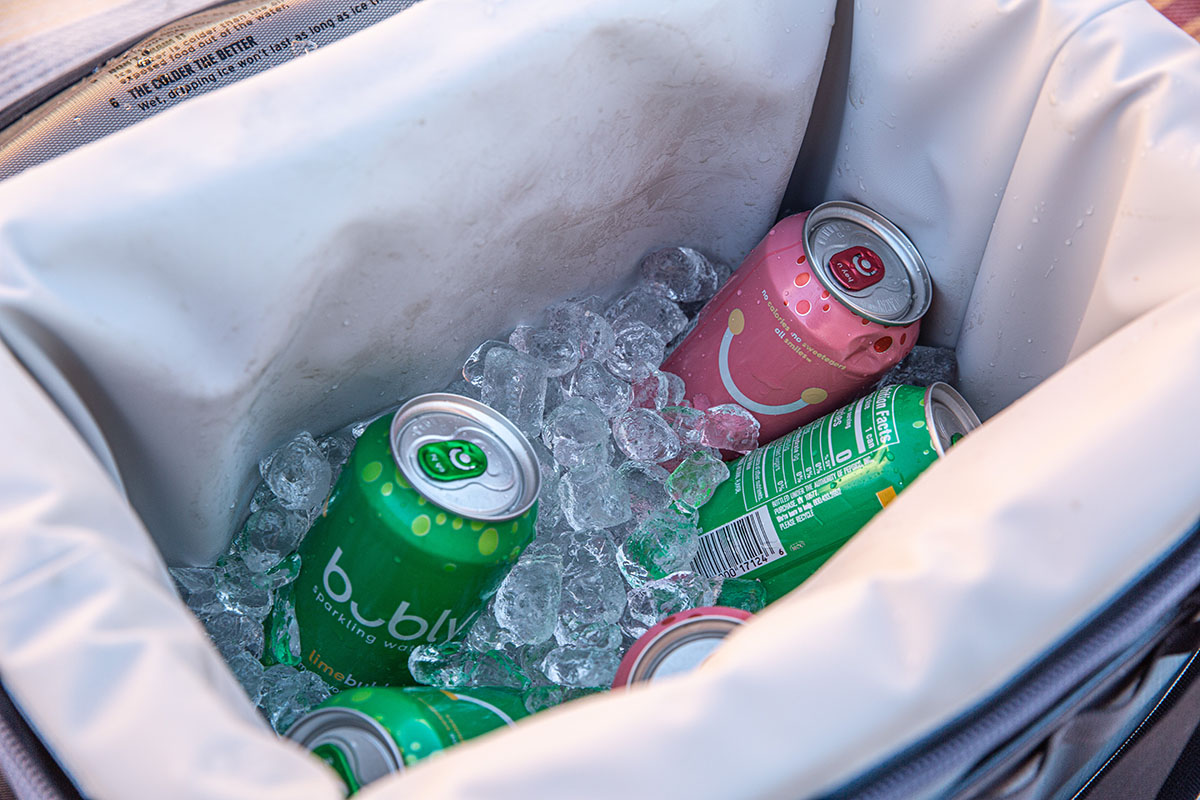
Most cooler manufacturers provide a “claimed ice retention” spec in their product listings (Yeti is one major brand who does not). From our list above, times range from just 12 hours for the cheap Coleman Chiller to three or four days for Engel’s premium HD30. That said, we always take manufacturer-provided specs with a grain of salt, and there isn’t an established, standardized test here. In practice, most of the claimed ice retention times feel quite inflated to us, perhaps due to extremely favorable testing conditions (storing the cooler inside with the lid closed in cool temperatures, for example). If we had to generalize it, we would say that you should expect to get approximately half of the claimed ice retention time in real-world use, give or take a bit depending on your specific circumstances.
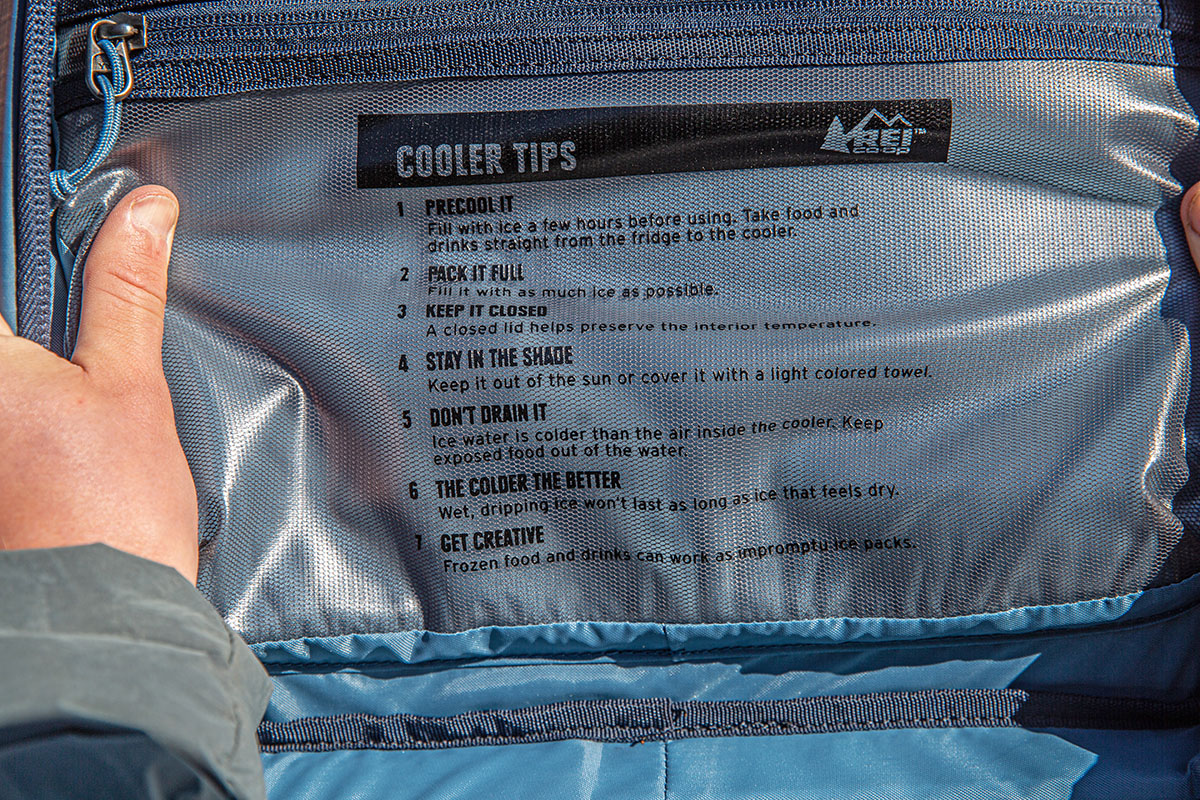
If there’s one clear benefit to soft coolers over hard-sided models, it’s that they’re significantly lighter and therefore much easier to tote around. A quick glance at our comparison table above reveals that most options hover somewhere in the 2- to 4-pound range, with the largest and most robust designs clocking in at 7 pounds or more. For reference, the Yeti Hopper M30 is the heaviest model on our list at 6 pounds 12.8 ounces, while smaller collapsible designs like the REI Co-op Campwell 18 L (1 lb. 2.3 oz.) and Hydro Flask 20 L Tote Bag (1 lb. 5.1 oz.) are the two lightest. On a related note, comfortable shoulder straps and/or grab handles can go a long way toward maximizing portability, which we outline in more depth below.

Durability varies considerably between soft coolers, and a good way to differentiate between models is to look at denier (D), which is a measurement of fabric thickness. Rigid designs like Yeti’s Hopper M30 and Engel’s HD30 (both 840D) sit at the top of the pack. These designs have tough exteriors that feel very confidence-inspiring around sharp gear and have stood up very well to regular use throughout testing with little wear to show for it. Softer and more malleable options like the REI Co-op Campwell feel significantly less burly and may be more prone to wear and tear over time, but they’re still reasonably well built for most casual outdoor uses.
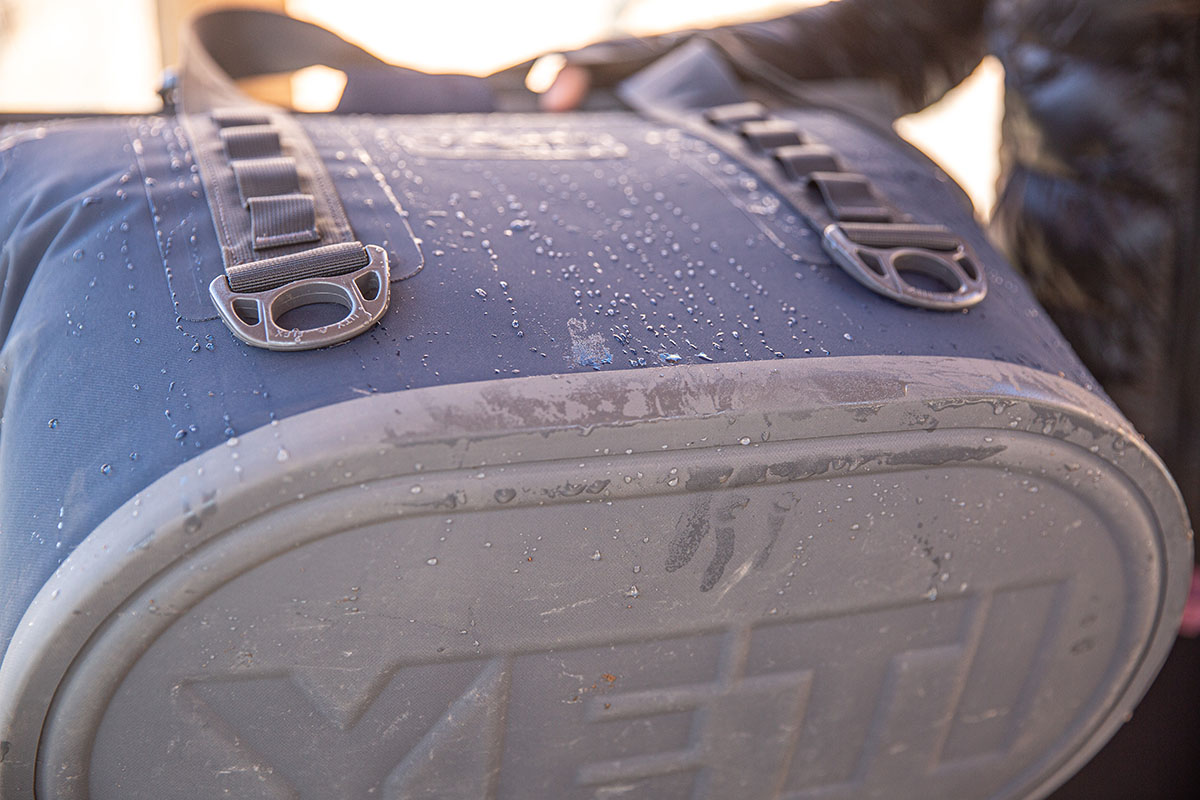
On a related note, it’s worth pointing out that price and build quality often correlate pretty closely: Options like the AO Coolers Canvas Series 24 Pack, Coleman Chiller 16-Can, and Arctic Zone Titan have noticeably cheaper-feeling constructions and components than their more premium counterparts. Again, these options may be perfectly serviceable for casual day trips and infrequent use, but committed outdoor-goers who plan to use their cooler regularly (and especially around water) will likely benefit from spending up.
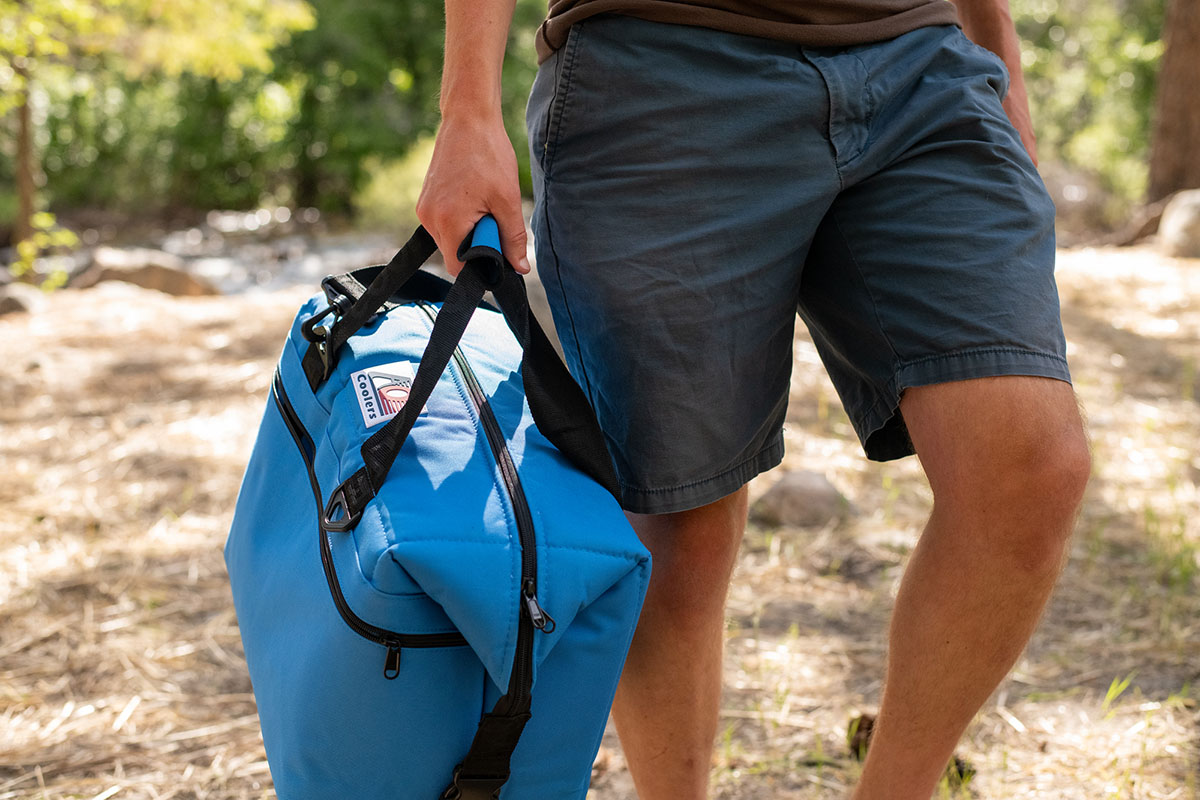
Waterproof Soft Coolers
Many of the coolers above utilize highly water-resistant zippers or openings, but very few have fully waterproof constructions. One exception is the Icemule Classic, which has a dry bag-like shape and exterior with a roll-top closure that can be fully submerged in water. This makes it particularly great for activities like kayaking or paddle boarding when it might be exposed to a lot of water. It also floats, which provides added assurance should conditions get rougher than expected. RTIC’s Ultra-Tough also falls into this category, and although it’s technically not fully waterproof, the tough shell and leakproof design should stand up well if it ends up taking a dip.
The price spread among soft coolers is significant, ranging from just $35 for the REI Co-op Campwell 18 L all the way up to $350 for Yeti's top-end Hopper M30. What do you get by spending up? As we touched on previously, durability and cost often correlate closely, with top-shelf designs like the M30, Hopper Flip 12, and Engel HD30 all boasting impressively thick and rigid exteriors that will stand up very well to long-term use. That said, even the cheapest options on our list are reasonably well built and will get the job done for days at the beach or packing a lunch on the road, which will be enough to sway many.
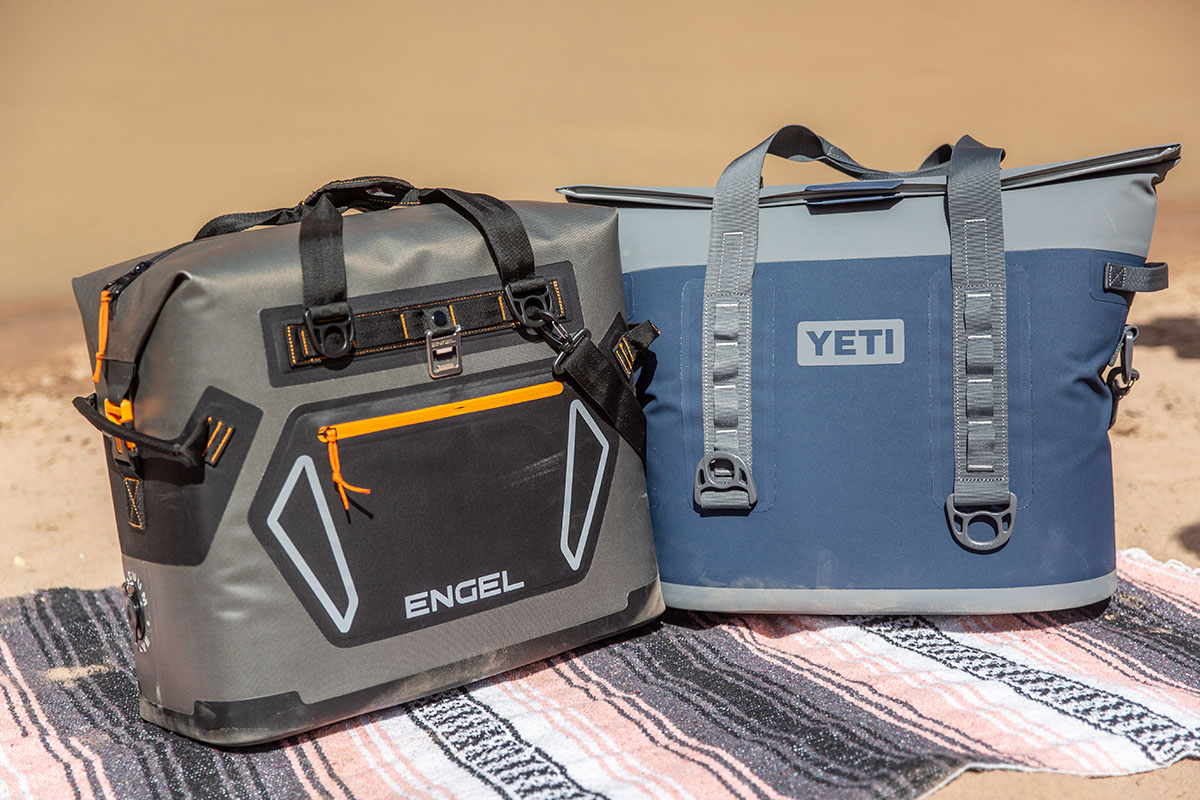
Additionally, unlike hard coolers, the difference in ice retention between soft-sided models isn’t all that sizable, which can make it harder to justify spending up for such a premium and expensive model. To be sure, these top-end designs have their appeal for those who want the easier portability of a soft cooler without compromising on build quality, but they’re not worth the investment for most. If you’ve got the budget, it’s almost certainly worth opting for a hard-sided model instead. You’ll incur a sizable weight penalty, but the boost in cooling capabilities and overall performance will be well worth that tradeoff for many.
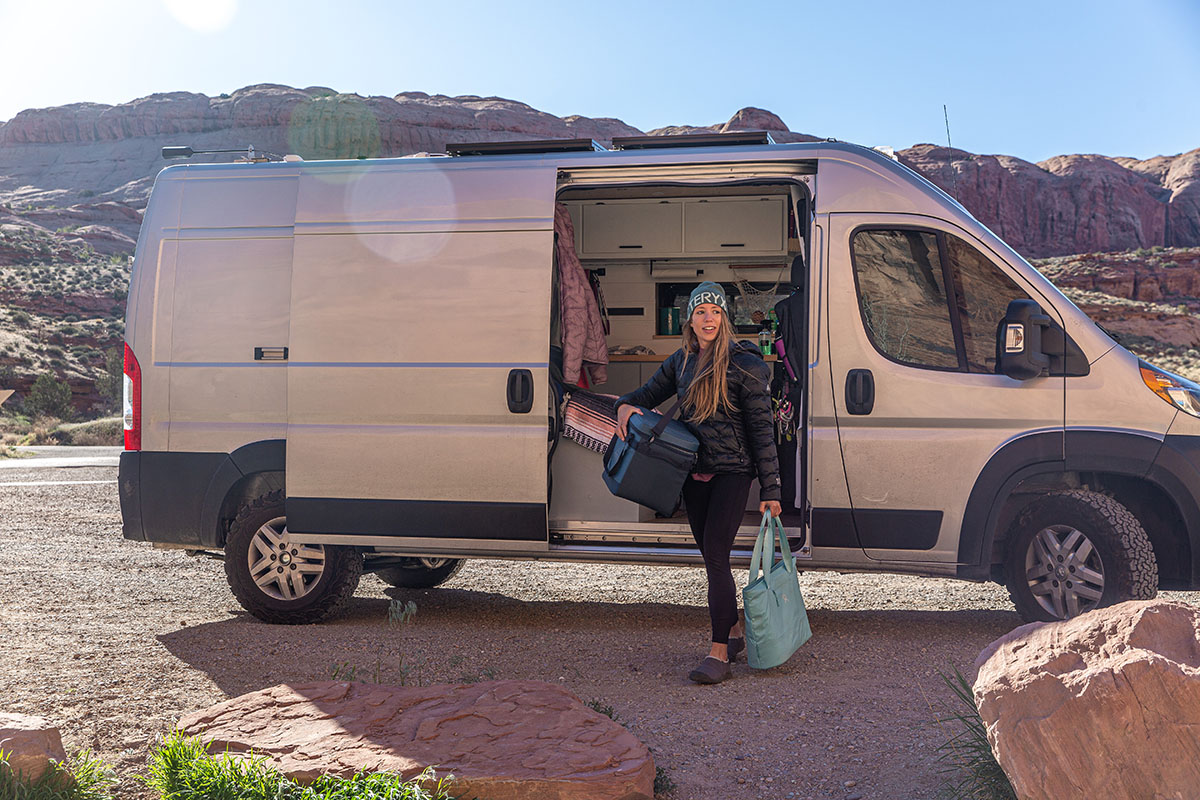
The opening style and closure system of a soft-sided cooler may not seem all that important, but we can tell you firsthand that it will have a sizable impact on both convenience and overall performance. And styles vary considerably between models. The Yeti Hopper M30, for instance, has a rigid magnet-equipped opening that requires considerable effort to keep open while loading and unloading food and drinks. Many zipper-equipped options, such as RTIC’s Ultra-Tough Soft Cooler and Engel’s HD30, also require significant force to operate the zippers, although the RTIC's wraparound design makes it easier to prop the lid open, and the upside is that these styles are often very resistant to leaks.
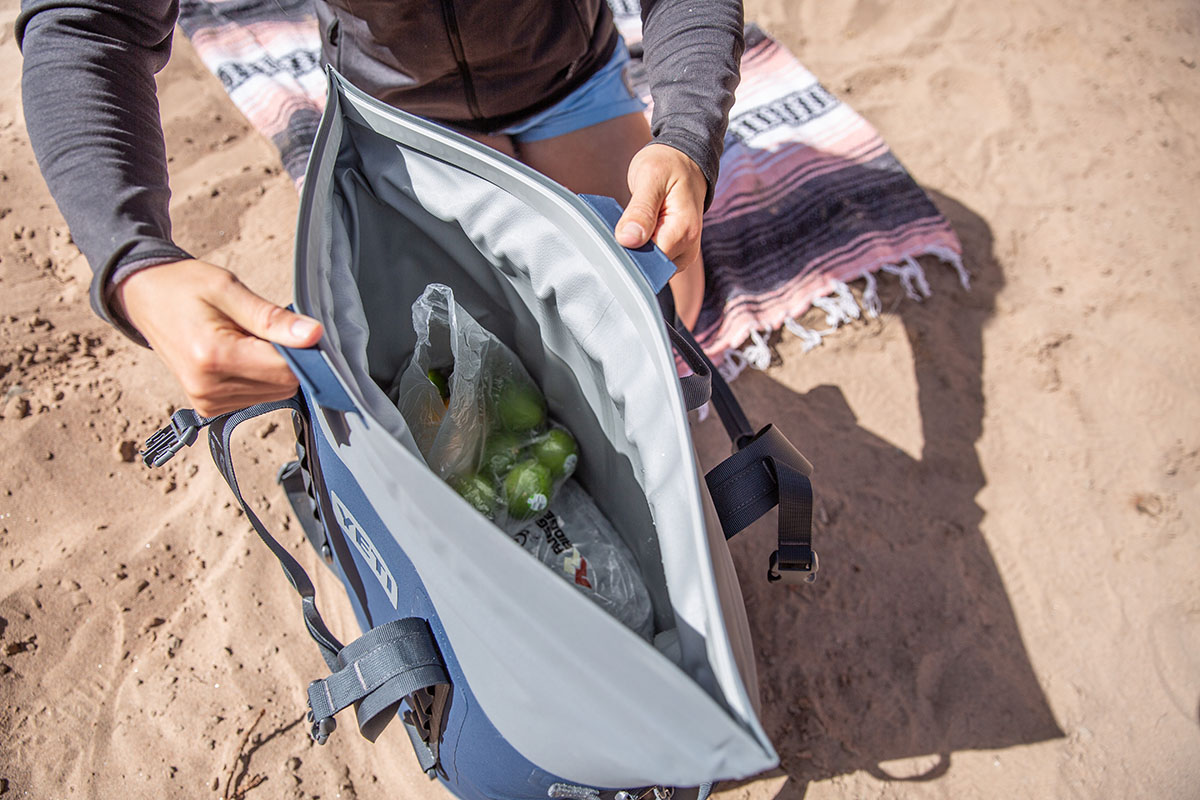
A couple of our favorite opening styles include the roll-top closure on Icemule’s Classic and the zipperless design on Arctic Zone’s Titan that secures closed with strong Velcro. However, keep in mind that while these are easier to open and close, they also provide less of a seal than zippered designs (read: They’re more prone to leaks) and often don’t insulate as well as a result. In the end, many will likely be willing to trade a bit of usability for the added security, insulation, and leak-proofing of a more robust opening.
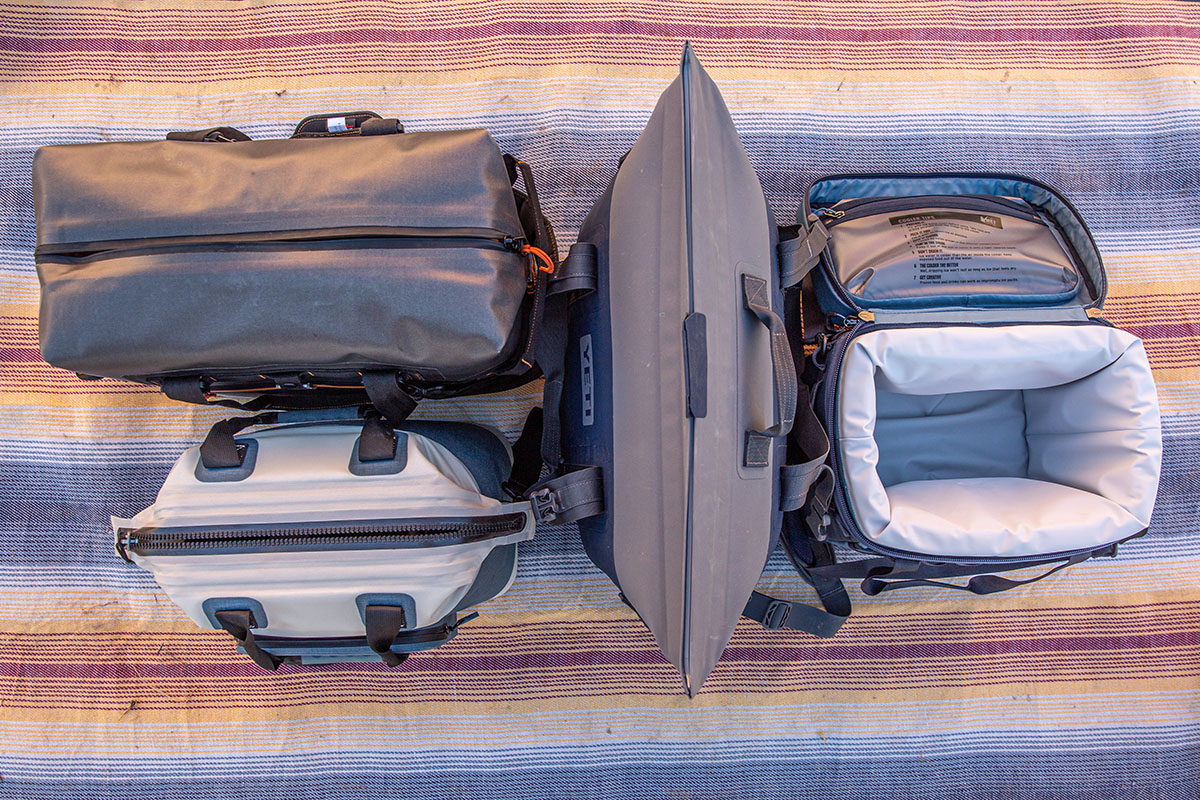
As we’ve covered above, soft coolers are far easier to haul around than their hard-sided counterparts. In addition to weighing less, most come with padded straps and thick grab handles for carrying solo over your shoulder or by hand. Premium models tend to have great cushioning along the straps, as evidenced by Yeti’s Hopper M30 and Engel’s HD30. Budget designs with more basic strap systems like those from AO Coolers, Coleman, and Arctic Zone aren’t as comfortable to carry over long distances, but they’re still decently portable and fully serviceable on short walks from your car. Backpack coolers like the Hydro Flask 20 L Day Escape are the easiest to manage with full harnesses that can be worn like a standard daypack (we outline these more in depth below).
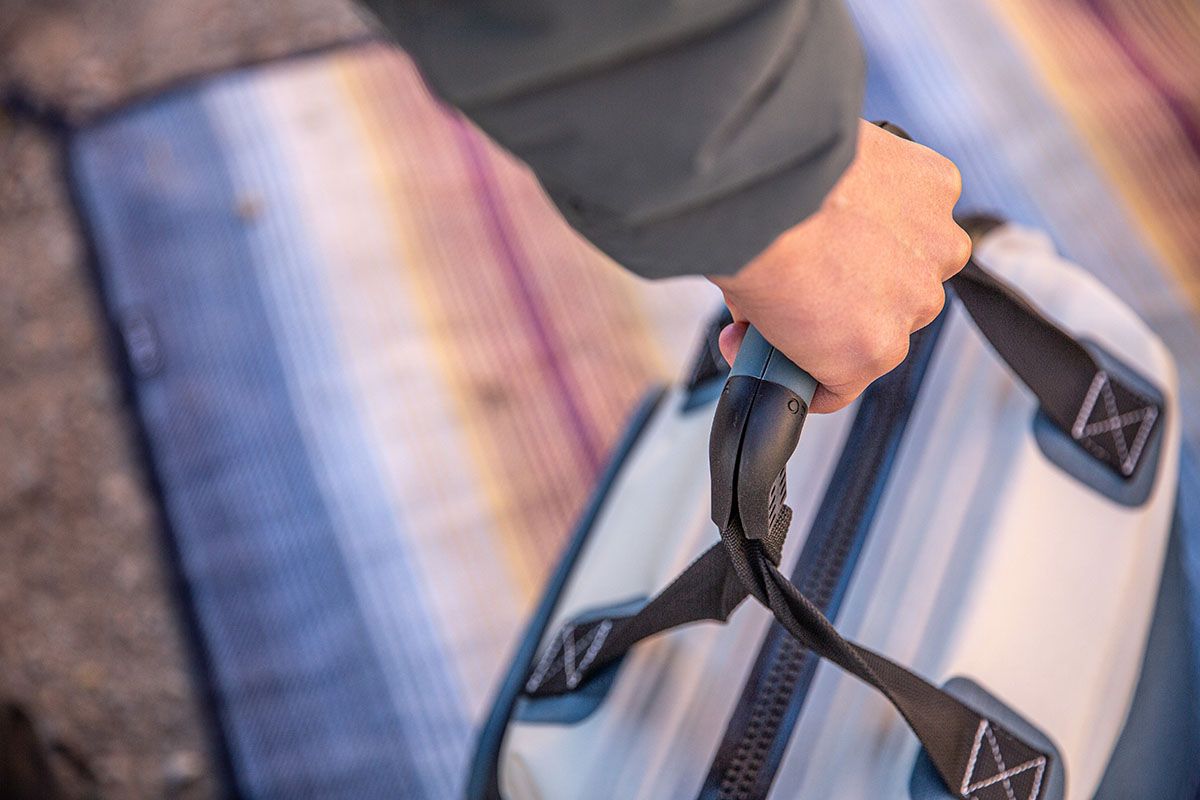
For the ultimate in portability, soft-sided backpack-style coolers are the way to go. The designs borrow heavily from hiking daypacks, sharing features like shoulder straps, padded backpanels, and exterior pockets for added gear storage. Like traditional soft-sided coolers, backpack models are lightweight, easy to carry, and pack down when not in use, but they still lack the insulating power of hard-sided coolers—the Hydro Flask 20 L Day Escape, for instance, is only rated to keep ice frozen for up to 36 hours. Additionally, backpack coolers are fairly expensive considering their modest storage capacity and all-around performance (the Day Escape is pretty average in this category at $200). But if the approach to your favorite picnic spot or fishing hole involves walking more than a half mile or so, it may be worth the investment. For more on the topic, check out our article on the best backpack coolers.
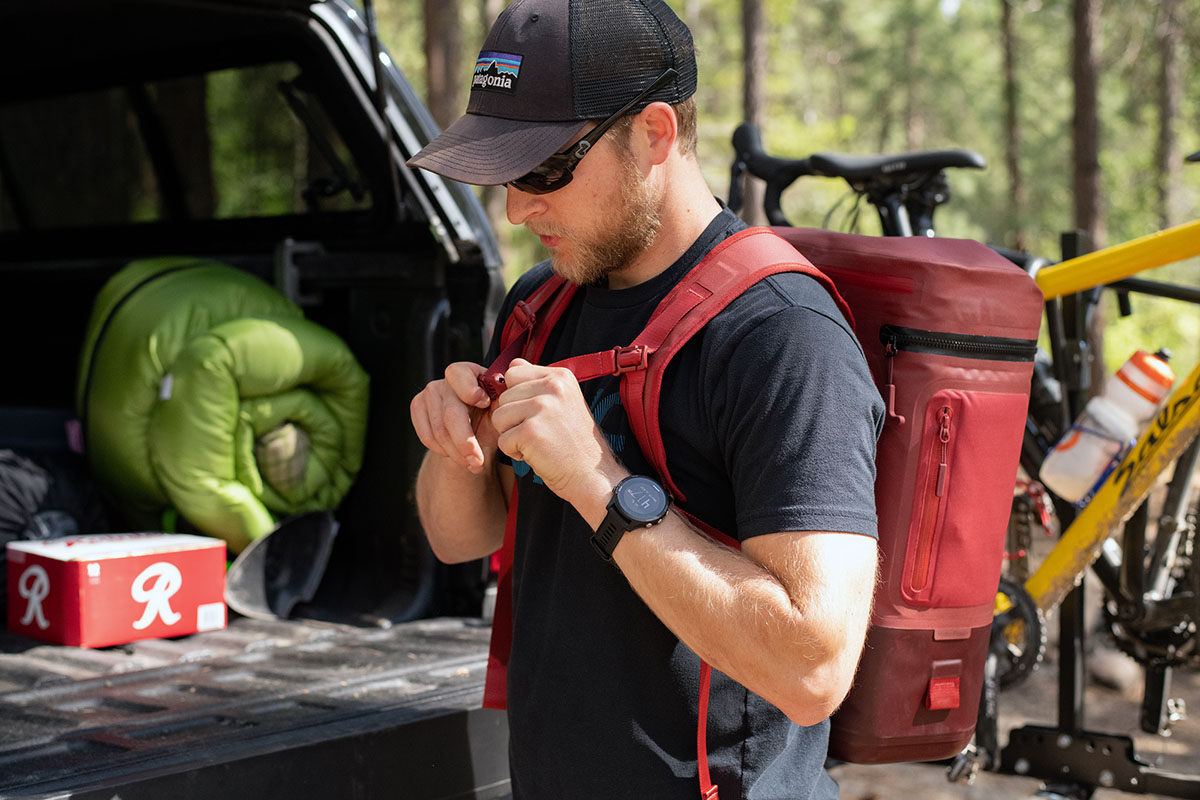
Pockets and Organization
Soft coolers come in a range of shapes and designs, but many include at least one exterior pocket for stashing small valuables like a phone, wallet, or keys. In use, we’ve found these to be incredibly useful and helpful for keeping track of our belongings whether we’re spending a day at a local state park or enjoying an afternoon at the beach. We also appreciate when these pockets are water-resistant, which provides a little extra assurance against splashes or precipitation. A couple models that include functional stash pockets include the RTIC Ultra-Tough Cooler and Arctic Zone Titan.
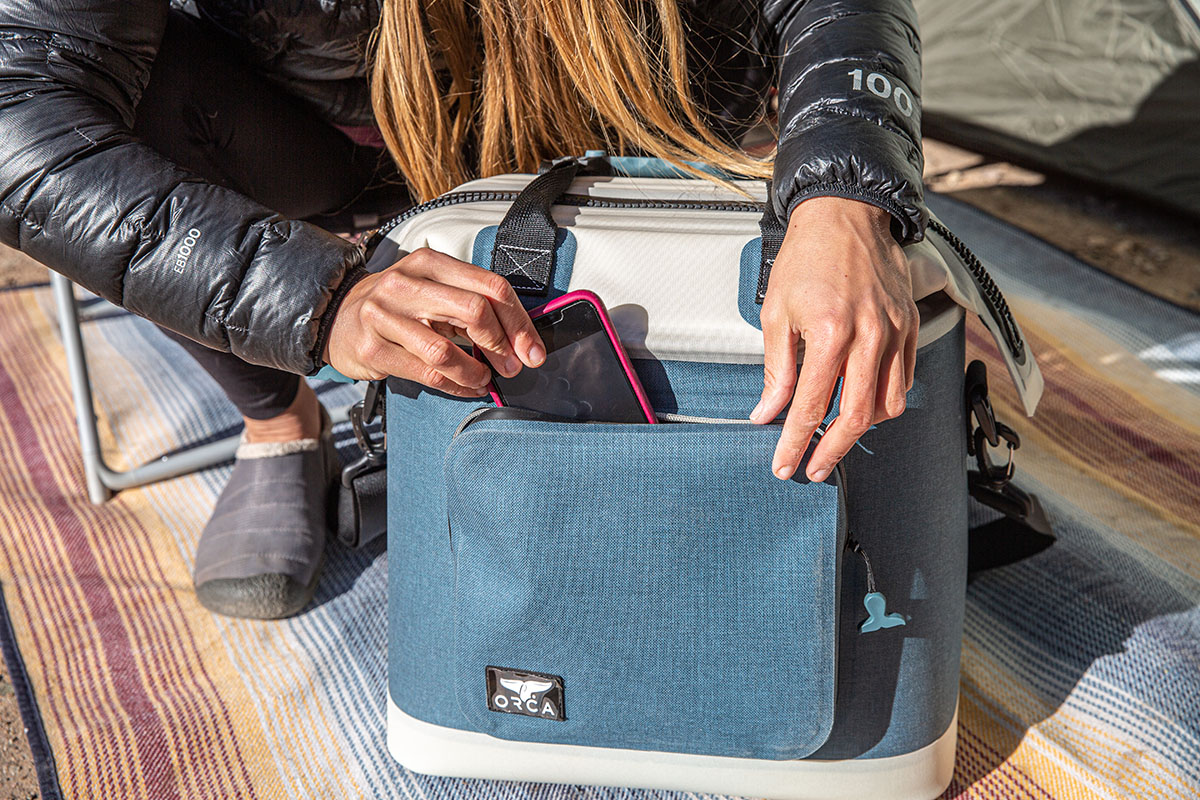
External Attachment Points
Several soft coolers on our list, including Yeti’s Hopper M30 and Hopper Flip 12, have daisy chain webbing along the outside for securing extra gear. In use, we’ve found this area useful for keeping valuables like keys close at hand (we use a carabiner to attach them). And we particularly like the stretchy bungee system on the Arctic Zone Titan, which makes it easy to secure a lightweight jacket or small towel on top.
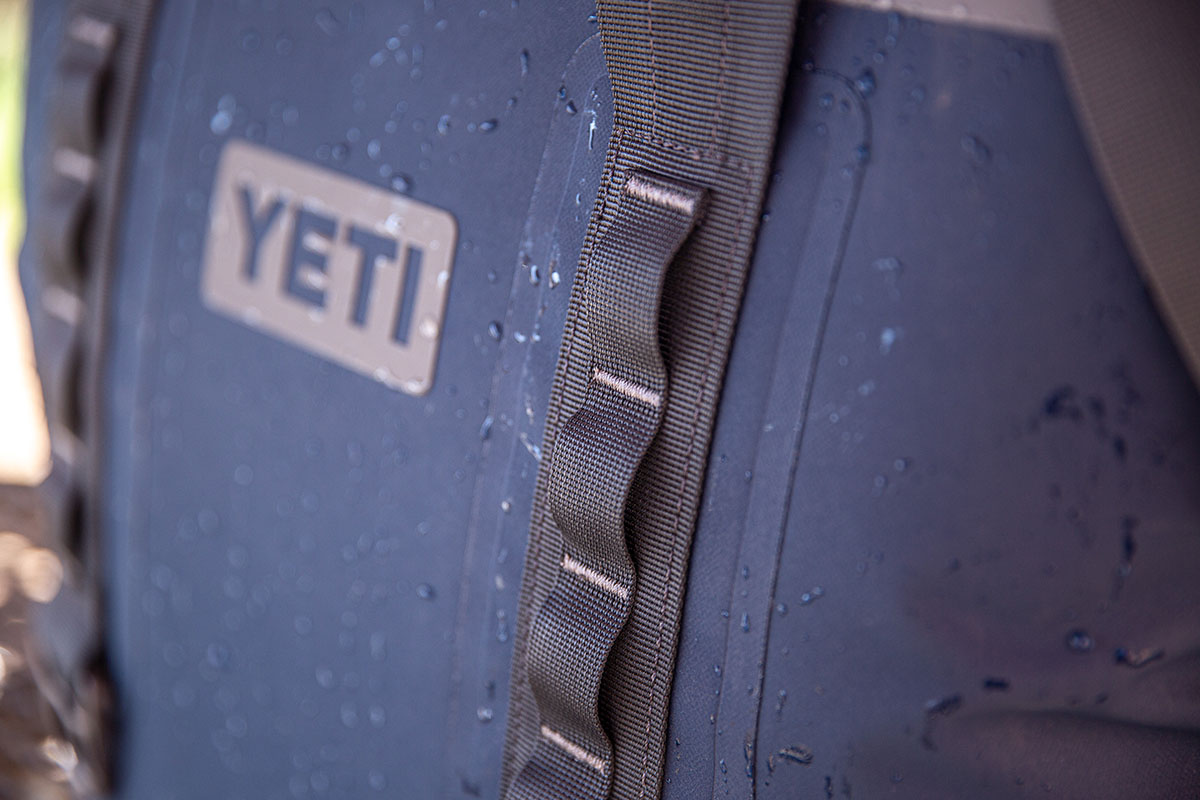
Other Features
A few other notable features to be on the lookout for include integrated bottle openers and vacuum ports for adding or releasing air. From our list above, the Engel HD30, Arctic Zone Titan, and REI Co-op Trailgate 20 come with bottle openers, and the HD30 also includes a unique vacuum valve that allows you to suck out excess air before use to maximize its insulation power. Icemule's Classic has a similar valve system, although in this case, the process involves adding air to boost cooling capabilities and buoyancy and removing it to compress the cooler down for storage. Two final features worth calling out are the Arctic Zone Titan’s shelf for separating hard and soft items and the REI Trailgate’s removable inner liner that allows you to use the shell separately as a tote.
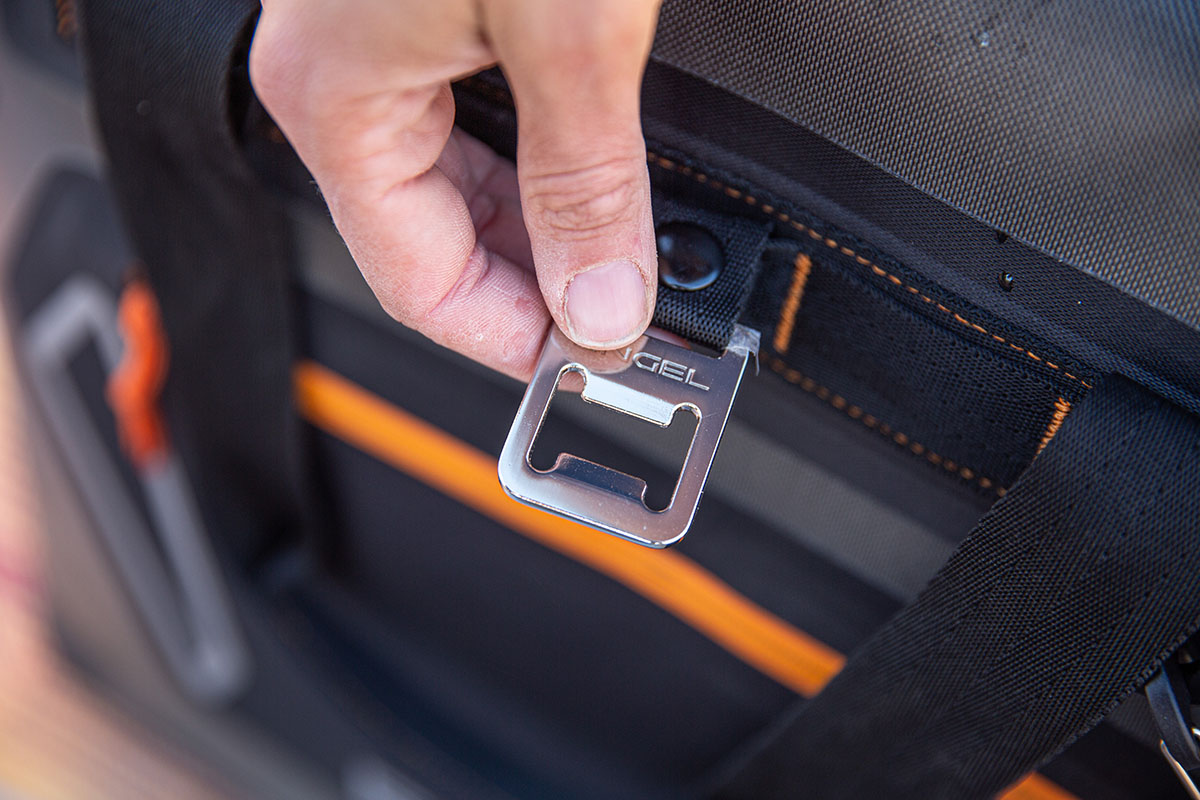
Many soft cooler manufacturers also sell compatible accessories that can attach directly to the outside of their coolers. For instance, Hydro Flask’s 20 L Day Escape has thread-through points on the outside for securing one of their Dry Storage Bags (offered in small, medium, and large sizes). Yeti's accessories for their soft coolers are relatively limited, although we do like their similar SideKick Dry Gear Case that attaches to the HitchPoint grid on their Hopper models, as well as the Molle Zinger for securing a multitool or bottle opener.
Most of us are accustomed to using crushed ice in our coolers, and for good reason: It’s cheap, readily available at most gas stations and supermarkets, and easily fills the gaps between food and beverages. That said, it’s also the fastest to melt and will need to be replaced fairly frequently, which we experienced firsthand while testing many of the models above in the Utah desert. After just a few hours in direct sunlight, most of the crushed ice we had dumped inside our various coolers had turned to water, resulting in soupy salad mix, wet and damaged food cartons, slimy cheese, and more. To make things worse, most soft coolers don’t come with drainage ports, which can make it difficult and tedious to remove excess water. All told, it was a relatively costly and very messy mistake that we won’t let happen again.
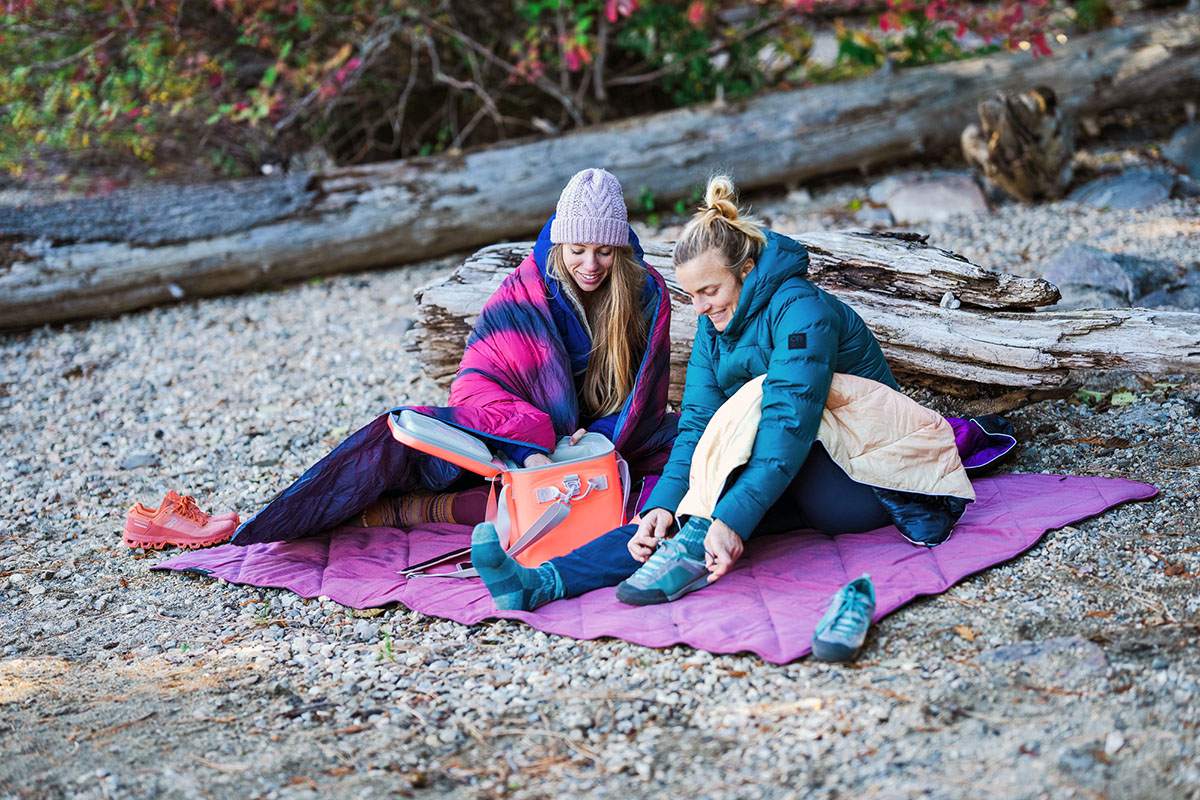
To prevent issues like these, we strongly recommend using dedicated ice packs in your soft cooler instead (unless you're only using the cooler to carry drinks and/or cans). To simplify the buying process, most major brands have their own designs that work well in their coolers, and the best part is that you can use them repeatedly without ever having to drain melted ice. They can be a fairly expensive addition (Yeti's range from $15 to $30 depending on size) and require refreezing once they lose their coldness, but they’re the simplest and least messy option for soft coolers. A final alternative is using blocks of ice, which take much longer to melt than crushed ice but are bulky and take up a lot of space. And one last note: Dry ice will damage the interior of most soft-side models, so be sure to steer clear and use one of the other options mentioned above.
Before investing in a soft cooler, it can be helpful and prudent to consider how long it’s covered under warranty. A one-year warranty is pretty standard in the soft cooler market, (like what you get with RTIC), while three to five years is fairly generous. For reference, Yeti and ORCA both offer three-year warranties on their soft coolers, while Hydro Flask leads the charge with a five-year policy. Importantly, all of these are limited warranties that solely cover defects in materials or workmanship and exclude damage from typical wear and tear. One exception is REI Co-op, which offers a full refund or replacement within one year of purchase for members (90 days for non-members). Finally, it’s worth noting that many companies provide different warranties for their hard-sided versus soft-sided offerings. For example, Yeti's hard-sided Tundra series is covered with a five-year warranty compared to three for the Hopper collection.
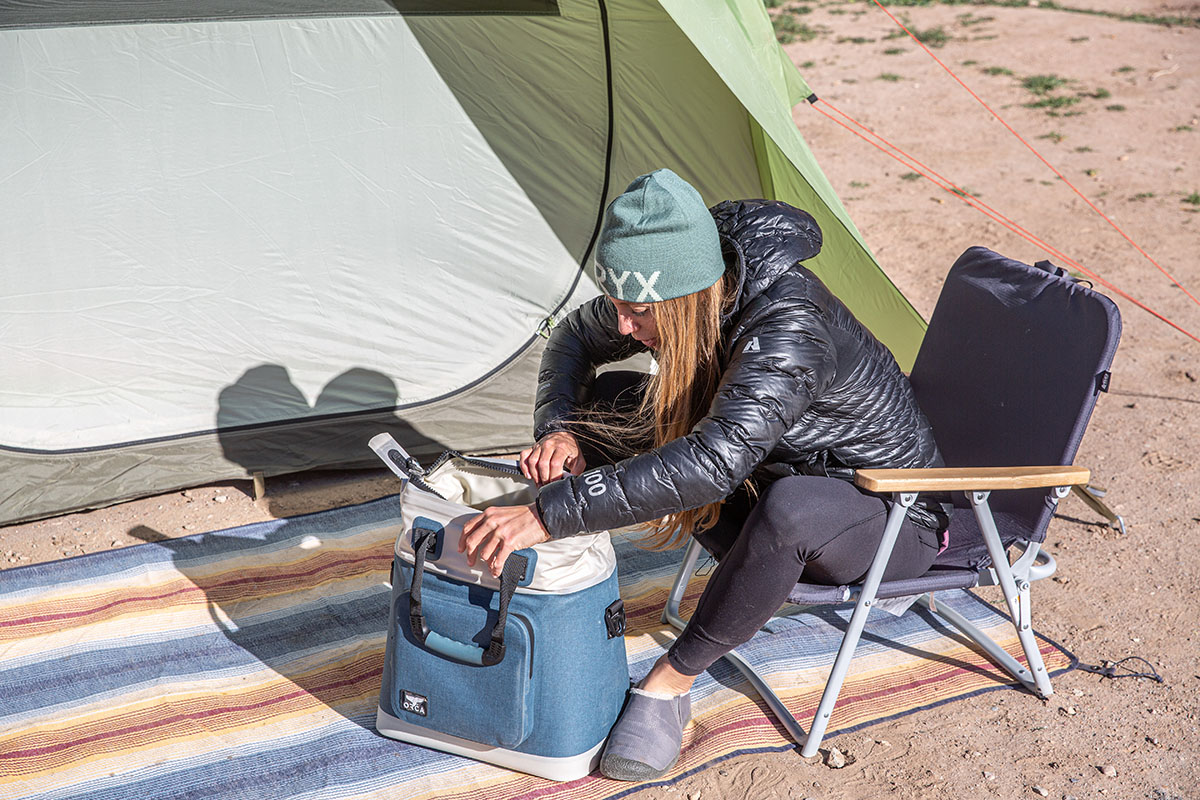
Most soft coolers have smooth liners, which makes cleaning a breeze. After each trip, simply use a clean towel with a mixture of warm water and mild soap to wipe everything down. For tough stains, apply a solution of baking soda and water and let it sit for about 20 minutes before washing it off. Pesky odors can be treated with a diluted mixture of bleach and water. Make sure to rinse thoroughly before leaving the cooler out to air dry with the lid open, which will minimize the chance of mold or mildew buildup. Once it’s dry, store your cooler in a dry place with the zipper closed. Finally, if any of the zippers are giving you issues, ensure there's no debris between the teeth and apply a lubricant (like Gear Aid’s Zipper Cleaner and Lubricant) on both sides to keep them running smoothly.
We exclusively cover soft-sided coolers above, which work well for those who just need a simple and portable option for road trips or day use. For multi-day trips, however, hard-sided models offer several added benefits over soft coolers. Namely, they retain ice for much longer (two to 10 days is standard), are inherently far more durable and hardwearing, and come in larger capacities. Many hard coolers also boast helpful features like drainage systems to help you empty out water once your ice has melted and lockable lids to bear-proof your cooler when camping in bear country.
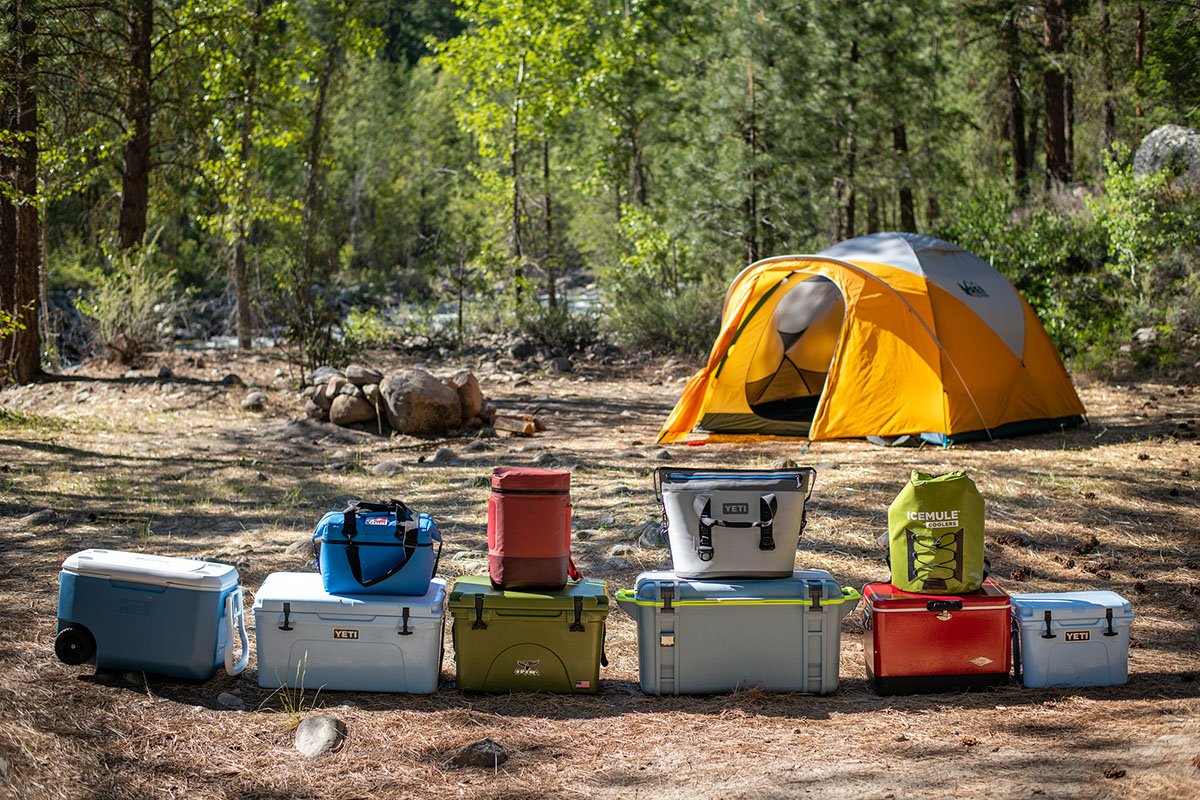
In terms of drawbacks, hard-sided coolers are significantly heavier, bulkier, pricier, and less portable than soft models, but most committed campers will find those tradeoffs worth it for the boost in overall performance. Some of our favorite designs include RTIC’s Ultra-Light lineup, Yeti's Tundra series, and Pelican's Elite collection. For a full list of options (including buying considerations specific to hard-sided offerings), check out our article on the best coolers. For those concerned about portability, we've also compiled a list of the best wheeled coolers, the vast majority of which are also hard-sided.
Back to Our Top Soft Cooler Picks Back to Our Soft Cooler Comparison Table